#2003 and 1990 my beloveds
Explore tagged Tumblr posts
Text
Just had another Mutant Mayhem thought: Raph doesnt have anger issues! He just has a lot of energy and like any teenage boy he thinks the only way to release that energy is through violence (beating up bad guys)
#tmnt#tmnt mutant mayhem#tmnt mm#i wished wed seen more bc there was a scene with raph and bebop and rocksteady were they were talking about this#and i loved it unfurtonately i couldnt quite catch everything they said#but it looked like raph just had age appropiate anger and a lot of energy he didnt know how to redirect#it also felt like those mentions were mainly played as a joke. and I laughed#but i definetly prefer it when its treated as an actual issue that affects raph and his fam and theyre worried about him#2003 and 1990 my beloveds
40 notes
·
View notes
Note
do you have a ranking for the mikeys or do you like them all the same (or at least a very similar amount)?
Kind of? I’ll break it down anyway:
2003 Mikey! Literally my favourite character across all versions, he’s obviously in top spot.
2007 Mikey has been oddly growing on me a lot since hearing about the sequels that never happened (come on, Mikey joining the foot? His brothers being mutated? I feel sad every time I think of these and what they could have been)
Mutant Mayhem Mikey. I mention this in my ranking post but seeing him gaze sadly at the surface through a sewer grate with that sad music has made me want to protect him forever.
Rise Mikey, 2019 Mikey, 1987 Mikey: all of these guys are the same for me, I love them but the top three just a tad bit more
Every other Mikey. Like I said I like all Mikeys, these guys just slightly less. I haven’t watched as much 2012 so 2012 Mikey kinda defaults to here I’m afraid, but what I’ve seen of him I don’t hate the dude at all.
#tmnt#rottmnt#rise of the tmnt#tmnt asks#asks and replies#tmnt mikey#tmnt 1987#tmnt 2012#tmnt 2003#tmnt 2007#tmnt bayverse#tmnt 2019#batman vs teenage mutant ninja turtles#tmnt 2023#tmnt mutant mayhem#tmnt 1990#MIKEY!#2003 mikey my beloved
40 notes
·
View notes
Text
Kind of a bonus post but here is how I'd rank the Leo's:
2012
2003
rise
mutant mayhem (might become my 3rd favorite after the movie depends)
IDW
1987
1990
2007
bayverse
whatever the hell that creature in next mutation was he doesn't deserve to be called Leo
#tmnt leo#tmnt 2012#tmnt 2003#tmnt 2k12#my opinion#tmnt leonardo#tmnt 2007#tmnt 2016#tmnt 2014#tmnt bayverse#tmnt 1987#tmnt 1990#tmnt idw#mutant mayhem#tmnt 2018#rottmnt#baby blue#leo my beloved#leo my king#blue king#teenage mutant ninja turtles#tmnt fandom#rise of the teenage mutant ninja turtles#tmnt
38 notes
·
View notes
Text
Have I out grown Take That or have they simply resorted to making music that would feature on the not hit 2003 album In Your Own Time by Mark Owen?
#The answer is both#But also this could be a disservice to the not hit 2003 album In Your Own Time by Mark Owen because i do love that album in its own way#Rip Take That 1990-1996 & 2005-2011#Sorry this is so niche and i don't think i have any take that followers anymore lmao#Beautiful World my most beloved album they will never reach those levels again
0 notes
Note
Hello. I have never seen an "teenage mutant ninja turtles" show, comic, or movie. The characters however, appeal to me. If any one show or movie would suffice, where should I begin? Other sources have not been helpful.
OHHH GODDD OK WELL. OK SO. the thing is that different iterations are SO different i'm not entirely convinced that comparing them to each other is very ?? helpful?? a lot of people these days get into tmnt through the 2018 animated show Rise of the Teenage Mutant Ninja turtles. HOWEVER, that show only has like 2 seasons and is not the end all be all of the tmnt universe.
it's kind of hard for me to advise you to watch or read any one specific piece of tmnt media to get into it, because I kind of just already knew about it the entire time growing up?? like i never really actively watched it but i was generally aware of the concept for my entire life.
and i'm not sure exactly ABOUT the tmnt characters interests you, so i wouldn't know where to point you.
with all that as a disclaimer here's some of the more popular film/tv shows (I'm about as lost as you when it comes to the comics to be honest)
ROTTMNT/rise of the teenage mutant ninja turtles. it's the newest series as far as i know and it has fantastic animation. it's very funny and lighthearted most of the time and the boys even get magic powers (eventually) it's the one that really got me into tmnt. this one kind of switches around the roles of the characters. Usually you'll see Raph being depicted as the rash one, or the one with anger issues who strikes out on his own (and i still think thats true to an extent in rottmnt) but he, as well as Leo, are definitely portrayed in a different way than normal in rottmnt. which i like tbh it's fun. (i could write a whole essay about how their characters are different but also kind of the same in rottmnt vs other media but that would take all day)
TMNT 2012 series. The 2012 series is very influential as well, and heavily beloved by many. I haven't seen all of it yet, but it's biggest drawbacks (to me at least) is its very 2010's american childrens show style of comedy which can come off as uncomfortably cruel/annoying if you aren't ok with it. it's also an early years CGI animated show, so sometimes things don't look as good as they could. STILL it's definitely interesting and i like the dynamics between the brothers there so I'd give it a chance.
TMNT 2003 series. honestly i havent heard a lot about this one, but i really like the style and ive watched a few episodes of it, and it's definitely solid, sorry i can't say much more than that.
TMNT 1987 series. also can't say much about this one but it is hella goofy from what i've watched of it. it's also the original cartoon series i believe, airing as a sort of "saturday morning cartoon" situation.
TMNT 1990 movie. this one is part of a trilogy of tmnt movies, but i've only seen the first and a half movies. I really enjoyed the first one, it was a fun time and kind of campy, and the guy who plays casey jones is cute. this one is live action and the turtle costumes can look off putting to some people, but personally i liked them.
im sure people in the replies/reblogs of this post will add their opinions too haha
155 notes
·
View notes
Text
Broadway Divas Tournament: Round 1C

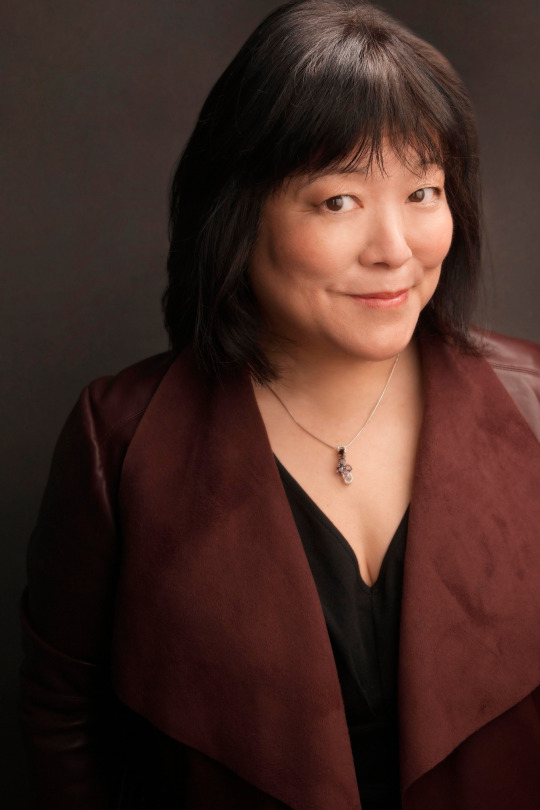
Multi-hyphenate LaChanze (1961) won her first Tony as Celie in The Color Purple (2006) and is known for her fantastic work in shows like Once On This Island (1990), Summer: The Donna Summer Musical (2018), and Trouble in Mind (2021). She is the only Diva to have two Tony Awards for producing, having won both of them last year, one for Kimberly Akimbo and the other for Topdog/Underdog. This season, she has produced Here Lies Love and Jaja's African Hair Braiding, and is co-producing The Outsiders.
Beloved character actress Ann Harada (1964) has a lengthy stage career with a propensity for stealing the show and audience's hearts. She's best known for playing Christmas Eve in Avenue Q (2003), and fairytales feature prominently on her resume with shows like Cinderella (2013), Fairycakes (2021), and Into the Woods (2022). She will appear off-Broadway this spring in Atlantic Theatre Company's The Welkin.
PROPAGANDA AND MEDIA UNDER CUT: ALL POLLS HERE

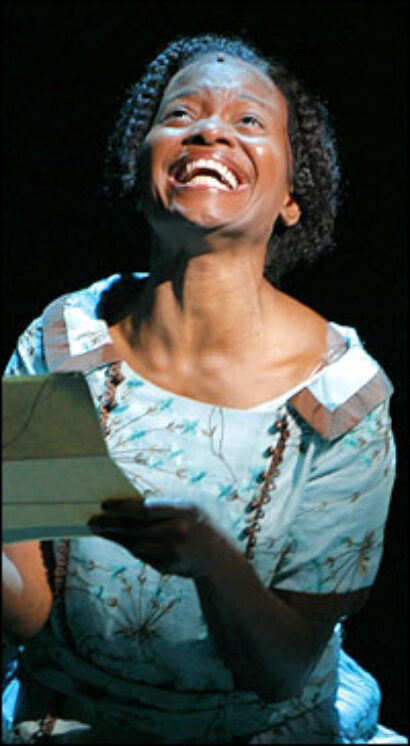
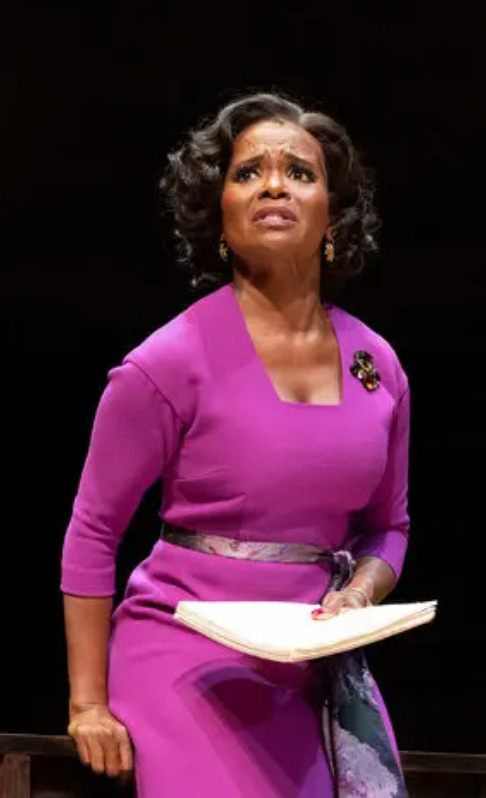
youtube
"Not only is she immensely talented onstage, but in her inaugural debut as a producer she won two Tonys in the same damn year. She won Best Musical for my beloved Kimberly Akimbo, and Best Play Revival for Topdog/Underdog, a fucking riveting show. And now she's got three more this season AND she's making her directorial debut with an off-Broadway show. Diva, Icon, That Bitch."

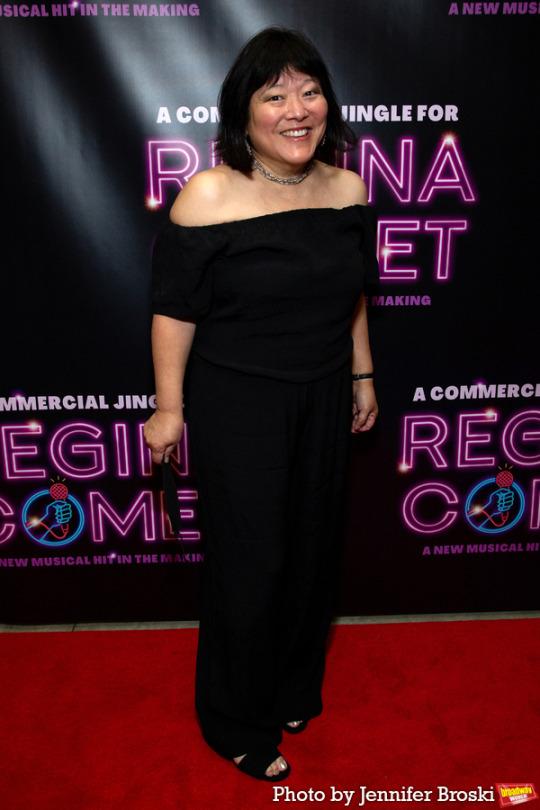
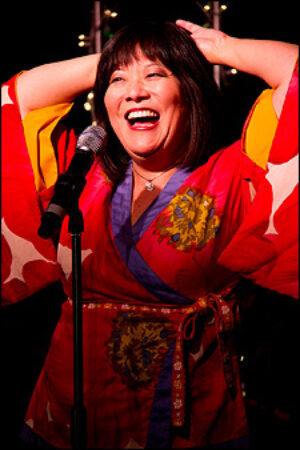
youtube
"You know, I see Ann Harada at shows all over the city all the time, in the cheap seats, unbothered, eternally cheerful. She's always happy to be there enjoying the art, and I like that. She had the audiences screaming in Dear World with her imaginary dog who was absolutely real and a vital part of the plot. The schtick she did got some of the most raucous applause of the night."
#broadwaydivastournament#broadway#broadway divas#musical theatre#tournament poll#lachanze#ann harada#round 1c
9 notes
·
View notes
Text
Film #488: 'Good Bye, Lenin!', dir. Wolfgang Becker, 2003.
When the list is so full of 'important' films, without any consideration to the actual pleasure of sitting with a text for two hours, it's a relief to be able to encounter a definitive crowd-pleaser. Good Bye, Lenin! is a film that I have recommended to many people, including my parents. It's the kind of film that was produced in Europe quite often in the late 1990s and early 2000s, and that I fondly remember looking through in the 'Festival' section of my local video store before those places ceased to exist - a mix of comedy and poignancy designed to get the audience thinking about things, but not on a particularly deep level. It's usually combined with a frenetic or notable style of cinematography or editing that sets it apart from the Hollywood fare of the time. So, the film makes for an enjoyable watch, and it's a well-produced and entertaining movie. And yet, halfway through my most recent watch, I found myself thinking... why is it on the list?
The list is not particularly revealing on the subject, either - most of its write-up on the film touches on the same issues I touch on above: its poignancy and humour. Its final paragraph does hint at one of the themes of the film, though: how a character's outward actions can make sense on a logical and narrative level, while possibly representing that character's deeper, unspoken concerns as well.
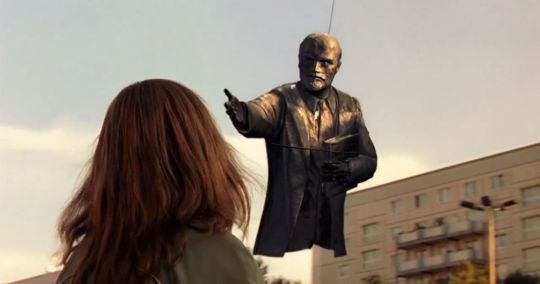
The life of the teenaged Alex (Daniel Brühl) is as stable as one can hope for in the dying years of the German separation. He has lived with his mother Christiane (Katrin Sass) and sister Ariane (Maria Simon) in East Berlin ever since his father left, apparently to live with another woman (and class traitor) in the West. His mother descended into a catatonic state until, partly as a result of Alex's love, she recovered and threw herself into socialist enthusiasm and civic work. By 1989, however, Alex has become disillusioned with East Germany's blind patriotism. His mother sees him arrested at an anti-government protest and suffers a heart attack, following which she falls into a long coma. The long-awaited political upheaval comes at a thoroughly inconvenient time - by the time Christiane awakens, the Berlin Wall has fallen and her beloved East Germany has ceased to exist. Warned by doctors that any shock might cause a fatal heart attack, Alex ropes his sister and friends into an elaborate deception so that Christiane never learns what has happened.
This level of deception is almost impossible to maintain, as before long even the view outside the bedroom window carries unmistakable signs of the march of capitalism. Alex has to spend his days sourcing jars from long-discontinued products, persuading his mother to give them access to her life savings so that they can secretly convert them into West German marks, and collaborating with his colleague to forge news programs explaining away the strange occurrences. Meanwhile, he has also fallen in love with Lara (Chulpan Khamatova), his mother's nurse who he briefly met at the protest. Lara is an understanding and empathetic partner, despite her reservations about the level of deception Alex is involved in. On a brief visit to the family's holiday home, Christiane reveals that her husband didn't actually abandon his family. Rather, he had made preparations for his family to join them in the west, and it was Christiane who refused to leave, worrying for the safety of her children. It seems the stress of this revelation causes her to relapse, and she is taken to the hospital that night. Alex manages to trace his father's whereabouts, and convinces him to visit Christiane in the hospital. Aware that his mother will probably not recover, he organises one final 'broadcast', in which East Germany's new president announces that the borders will be opened to the west. He shows his mother this broadcast, unaware that Lara has already revealed the truth to her: touched by the level of love and care her son has shown, she pretends to believe the news report. Christiane dies a few days after the German reunification, with Alex secure in the knowledge that his mother believed in a change in German society more aligned with her politics than the messy reality.
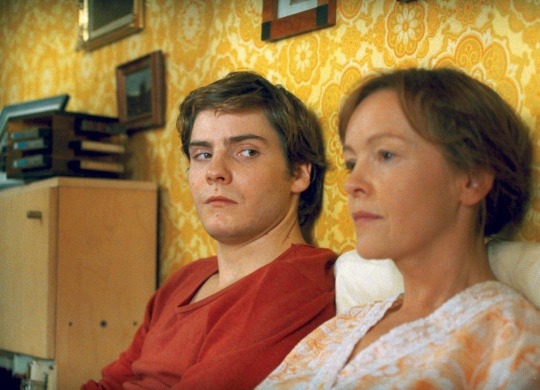
While Good Bye, Lenin! is a touching and entertaining film, there's not too much about it that feels special, which is why I was a little mystified to see it here. The commitment the film has to its central story means that it moves at a brisk pace, but this commitment does mean that it lets some of its plot threads dangle, especially towards the end of the film. Ariane, who has left her studies to get a job at Burger King, sees her long-lost father in the drive-through one night. Distraught by his apparent lack of communication over the years, she refuses to speak to him when she sees him at the hospital. The film doesn't show any kind of reconciliation between the two, nor does it get bogged down in any kind of complexity when it comes to Alex and Lara's relationship. Lara is angry at Alex for his deception, but then she is supportive. Aside from telling Christiane what has really happened while she has been isolated from the outside world, there is no process of acceptance or negotiation. The film would like the audience to always be aware of the absurd practical complexity of this ruse, but to dismiss the emotional complexity as unimportant. Too much focus on the ethical implications would kill the lightness of the mood. As an example, Christiane's amnesia means that she has initially forgotten where she hid her life savings. The pressure Alex and Ariane put on her to remember is understandable, as there is a deadline for the exchange of the old currency into the new, but without Christiane knowing the true context, the scene carries an edge of harassment. At last, she remembers that she hid the money in a piece of furniture that was put out for trash collection. Conveniently (although perhaps six months might have passed?) the discarded furniture is still there, so Alex can retrieve the money, but it is slightly after the exchange deadline. The next scene shows a drunk Alex hurling the useless banknotes into the wind. While the outward tone of the scene is zany, the film is constantly prodding at a twin pair of pains: the pain of duping Christiane, and the pain of losing hundreds of thousands of marks. What's more, these concerns never really reappear in the film - they've served their comic purpose and can be discarded.
I don't want to imply that this is a failure of the film on any level, but it's an indication that Becker is trying to strike a balance that doesn't feel quite right. There are no shortage of sequences which are hilarious and cringeworthy in equal measure, but in a good way: a massive billboard for Coca-Cola interrupts a birthday party, and Alex races to invent a news bulletin that reveals that Coca-Cola has been an East German invention all along. For every two comfortably funny scenes, though, there is one that slices a bit too close to the bone, and lays bare Lara's perspective, that the deception has pushed beyond a defensible level. The end result, with everyone gathered amicably at the scattering of Christiane's ashes, feels like a neat closure that isn't fully earned - one that waves away too many inconvenient details.

Some Marxist commentary has been put forward on the film suggesting that Alex is a clear representative of 'Ostalgie': a nostalgia for East Berlin that arose in some Germans following disillusionment with the West and its capitalist ruling structures. While it is true that Alex has a fondness for some of the cultural touchstones of the pre-reunification lifestyle, with apologies to the writers at the Green Left Weekly, I think this is an over-simplification of the emotional message of the film, and it also overlooks the obvious fact that Alex, Lara and Ariane are all pro-West. There are certainly some indications of capitalist malaise in the film (and some humour is wrung from this, such as the sight of various demographics of people all crammed into a shop to mindlessly watch soft-core pornography). Overall, though, Alex's intentions here are not to recapture the experiences of East Berlin for his own sake, but rather because this period of political history has become inextricably linked with his mother. The death of East Berlin is synonymous for Alex with the death of his mother, and he seeks to make the latter less painful for himself by easing his mother out of the former. As he says in voiceover, he wants to give East Berlin the send-off it deserved, and that logic easily extends to Christiane. The final faux-broadcast could have been an unvarnished advocacy of the new Germany - Alex even summons one of his childhood heroes, a German cosmonaut who now drives a taxi, and temporarily fashions him into a new German leader - but the content of the final broadcast is a plea in favour of the open-hearted community spirit that belongs to Christiane. That's what makes the scene so affecting: it's a pageant put on for one woman, who experiences the last few moments with the understanding that her son is who he is because of her. In the final scene where they spread Christiane's ashes by attaching them to a model rocket, Alex wryly observes that neither East or West Berlin would have legally allowed this to happen, a sign that his mother's wishes supersede any political structure.
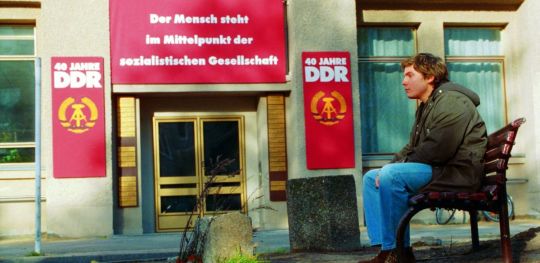
Good Bye, Lenin! is an unusual film on its surface, but it's not one that is so unusual in any aspect that it obviously belongs here. On a granular level, the list is always going to be arbitrary, but the familiarity of this film and its techniques (editing from Run Lola Run; a soundtrack by Yann Tiersen that reuses a piece from Amelie two years earlier) mean that it's not indispensable by any means. I think that's okay - they can't all be groundbreaking experiments in cinema, and sometimes it's enough for something just to be pleasing. And if something like this is going to be a general audience's first encounter with popular German cinema, things could be far, far worse.
6 notes
·
View notes
Note
What's your fav film?
Or top 5 if you can't pick one!
Nice try security question guesser! But you can have another 5 that I really love <3

Moon - 2009 - Astronaut Sam Bell has a quintessentially personal encounter toward the end of his three-year stint on the Moon, where he, working alongside his computer, GERTY, sends back to Earth parcels of a resource that has helped diminish our planet's power problems.
Amazing movie - So well acted and comes with the humor and angst I love in my movies

American Psycho - 2000 - A wealthy New York City investment banking executive, Patrick Bateman, hides his alternate psychopathic ego from his co-workers and friends as he delves deeper into his violent, hedonistic fantasies.
Violent, psychological, pain. The book is also one of my favourites. If you can handle blood then watch this!

Goodbye Lenin - 2003 - 1990, to protect his fragile mother from a fatal shock after a long coma, a young man must keep her from learning that her beloved nation of East Germany as she knew it has disappeared.
Funny, sad, dramatic. One of my favourites for all time. Also gave me my love for Daniel Brühl before he went big stateside. I still say he should be Gale in the live action.

Birdman or (The Unexpected Virtue of Ignorance) - 2014 - A washed-up superhero actor attempts to revive his fading career by writing, directing, and starring in a Broadway production.
I love Keaton films, and this is one of his best. The cinematography is fucking amazing. His acting is so good and it's just so good being in that headspace for this.

Back to the Future 2 - 1989 - After visiting 2015, Marty McFly must repeat his visit to 1955 to prevent disastrous changes to 1985...without interfering with his first trip.
It's back to the fucking future. Can I also mentioned that 2015 was 9 years ago and we still don't have flying cars or the abolishment of lawyers.
4 notes
·
View notes
Text

https://thehill.com/opinion/campaign/4709465-liberals-have-lost-their-patriotism/
Liberals have lost their patriotism
By: David Bernstein
Published: Jun 9, 2024
I came of age in the 1980s and 1990s in a Democratic Party and a social milieu that was unabashedly patriotic. To be sure, political liberals back then could be critical of America’s past and present, but most saw our country as an imperfect nation aspiring toward but often falling short in living up to its own high ideals. The dominant zeitgeist of the political right was dangerously nativist and insufficiently self-reflective.
President Bill Clinton, on whose campaign I worked in 1992, famously pronounced at his first inaugural speech, “There is nothing wrong with America that cannot be cured by what is right with America.” Young liberals in those days were animated by a form of American exceptionalism that elevated the idea of pluralism. In my twenties I wore a T-shirt broadcasting the American motto e pluribus unum—”out of many, one.” This was liberal patriotism.
Yet this center-left, glass-half-full narrative of our national experiment has increasingly yielded to a withering appraisal of American life, one that is rapidly becoming a self-fulling prophecy.
Today’s liberals rarely express patriotic sentiment in public, abandoning their civic voice to a far left that holds America in contempt, which in turn generates a politics that is both defeatist in tone and alienating to ordinary Americans. A nation that thinks less of itself will become less of itself. Mainstream liberals badly need to rediscover their patriotic spirit.
When beloved actress Betty White died at the age of 99, my wife began rewatching old episodes of The Golden Girls, a mid-1980s sitcom about four aging women who lived together and experienced the highs and lows of their golden years. In one episode, the strong-willed Dorothy lectured her Italian-born mother, Sophia, on the meaning of America.
“When I was a little girl,” Dorothy stated, “you told me how much it meant to you when you came here to America for the first time. Do you remember what you thought of when you first saw the Statue of Liberty holding up her torch of freedom? … Ma, you taught me to love this country. … You were the first one who put an American flag in my hand.”
I was instantly struck at how quaint this monologue was in today’s cultural context, especially coming from a show that was on the vanguard of such social issues as gay rights and sexual harassment. Sadly, this kind of flagrant patriotic sentiment would be considered cringe in today’s liberal circles.
A 2023 Gallup poll found that national pride on the left has precipitously declined in the past two decades. In 2003, 65 percent of Americans identifying as Democrats felt “extreme pride” in their country; by 2023 it was 29 percent. Only 18 percent of those aged 18 to 34 indicated that they were “extremely” patriotic, a steep decline from 85 percent in 2013. “Party identification remains the greatest demographic differentiator in expressions of national pride,” stated Gallup, “and Republicans have been consistently more likely than Democrats and independents to express pride in being American.”
On a recent drive in West Virginia, I noticed American flags outside many homes — even on those in economically depressed coal-mining towns, where people could be forgiven for feeling their country had abandoned them. When we returned to our neighborhood in North Potomac, Md., an economically thriving, politically blue area, I counted one American flag in four blocks, unsurprisingly mounted on the doorway of an Eastern European refugee who fled a repressive Soviet republic.
So inured had I become to the lack of patriotic sentiment in my neck of the woods that I found it positively inspiring in May of this year when fraternity brothers at UNC Chapel Hill rehoisted the American flag on the campus quad after radical activists had replaced Old Glory with a Palestinian flag. The young men locked arms and refused to budge as protestors reportedly hurled bottles, rocks and insults.
Why have liberals become less patriotic?
Some blame an American public that elected Donald Trump and social factors such as persistent economic inequality. Others cite social media echo chambers that extol, for example, a letter from Osama Bin Laden justifying terrorism against the U.S. Others point to the rise of an oppressed-oppressor ideology that sees America as pervasively racist. Indeed, when universities adopt policies that deem such comments as “America is the land of opportunity” and “Everyone can succeed in this society” as “microaggressions,” it should surprise no one that many students adopt negative attitudes toward their own country.
A few Democrats understand that a politics of self-loathing will never win the day. Maryland Gov. Wes Moore and Pennsylvania Gov. Josh Shapiro, both Democrats elected in 2022, successfully ran on liberal policy agendas that emphasized freedom and American exceptionalism. President Biden himself may still represent the old flag-waving sensibility, but the larger progressive political class that accompanied him to power exudes little passion and, judging by the president’s recent demoralizing speech at Morehouse College, has brought the president down with them.
Come November, we shouldn’t be surprised if many ordinary citizens opt for churlish nativism over a politics devoid of love of country. Liberals desperately need to get it back.
David Bernstein is the founder of the Jewish Institute for Liberal Values and author of “Woke Antisemitism: How a Progressive Ideology Harms Jews.”
==
It's become fashionable to pretend to hate your own safe, free, liberal country. Among such people, it's also common to find strident opposition to any measures to limit or control immigration. "My country is evil and racist, but you're not allowed to stop people arriving here."
4 notes
·
View notes
Text
CE Characters Favorite Disney Movies, Part II

Pete Brenner
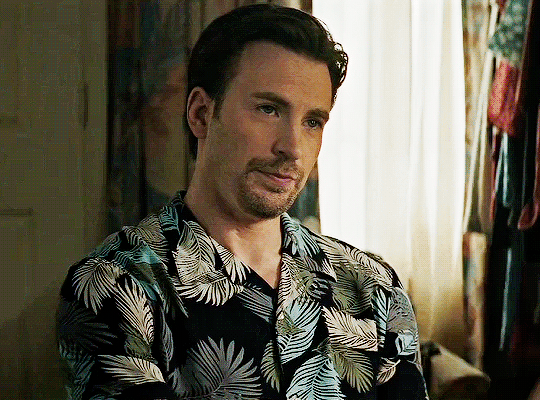
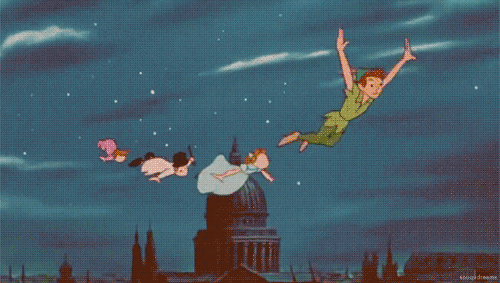
Peter Pan. Released on February 3, 1953. Growing up, Pete always loved Peter Pan.

Pete's Dragon. Released on November 3, 1977. This movie was one of the first movies that combined animation sequences with live action sequences. This makes sense that Pete would love a movie that has his name in it. Pete always felt that this movie was made just for him.
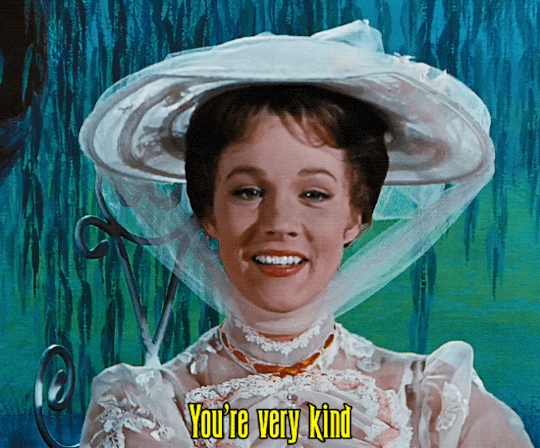
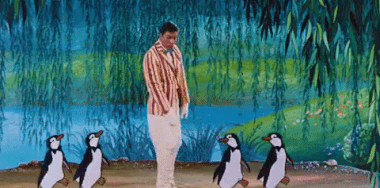
Mary Poppins. Released on August 27, 1964. It's one of the few movies where the movie is more well known than the book it's based on. P.L. Travers wrote the book, and had to be persuaded by Walt Disney to sell the film rights. The 2013 Disney movie Saving Mr. Banks is about this. Now, Mary Poppins is a much beloved Disney film, much like the Wizard of Oz. Dick Van Dyke, who plays Burt the Chimney Sweep, was also starring in his own sitcom, The Dick Van Dyke Show.
Pete very much loves Mary Poppins. This is his favorite comfort movie, he even watches it when he's sick. (Mine's A Christmas Story.) Now, Zoe and her sister, Mary, love it, and even sing along and dance to the songs.
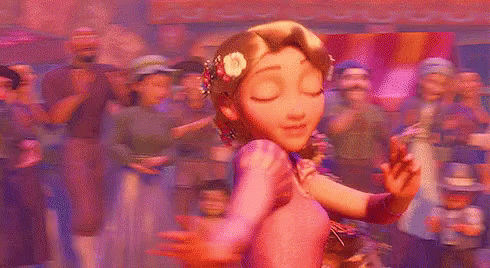
Tangled. Released on November 23, 2010. This is Zoe's favorite movie. Rapunzel is Zoe's favorite story, so it makes sense that Zoe loves Tangled. When Zoe wants to watch Tangled, she'll always say "Wapunzel!" She introduced this to Mary, and Mary says "Punzel!" when Mary is old enough to talk. Zoe and Mary will watch Tangled while eating their healthy snacks that are toddler and kid friendly.

Cole Turner

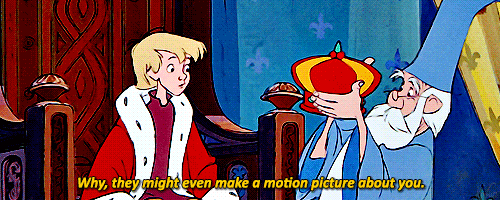
The Sword in the Stone. Released on December 25, 1963. It also stars Alan Napier as the voice of Sir Pellnore. Alan Napier was also shooting the 1960's series Batman, which aired Saturday mornings on ABC. ABC is Disney owned. Cole can't understand why he's drawn to this, but he is. It's always been his favorite Disney movie, and yet he can't understand why.
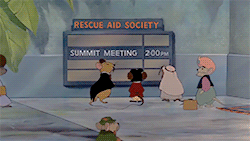
The Rescuers. Released on June 22, 1977. Bob Newhart was starring in the Bob Newhart Show. I even have a Little Golden Book of this movie.
This is another one of Cole's favorite movies that he never understood why he was drawn to, but now he knows.
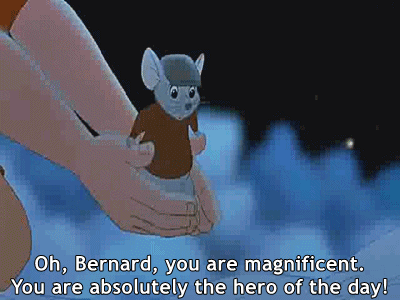

The Rescuers Down Under. Released on November 16, 1990. I saw this in the theatre when I was 11. The late, great John Candy does the voice of Wilber. John Candy was a Canadian comedian, who was an alum of SCTV, with Eugene Levy and Catherine O' Hara.
Cole loves the sequel because he got to be your hero. He not only changed your flat tire, you got bitten by a poisonous snake when you were on a field trip on his farm with your students. He not only used his shirt as a tourniquet to stop the venom from spreading, he picked you up, carried you bridal style to his truck, and got you to the hospital quickly. Luckily, one of the dads on the trip happened to be a paramedic, and knew exactly what to do, and knew that an ambulance couldn't wait. He refused to leave your side. Cole took care of you even well after you were given the anti-venom. Cole treated you to a date night after that.
Lucas and Dawn love The Rescuers
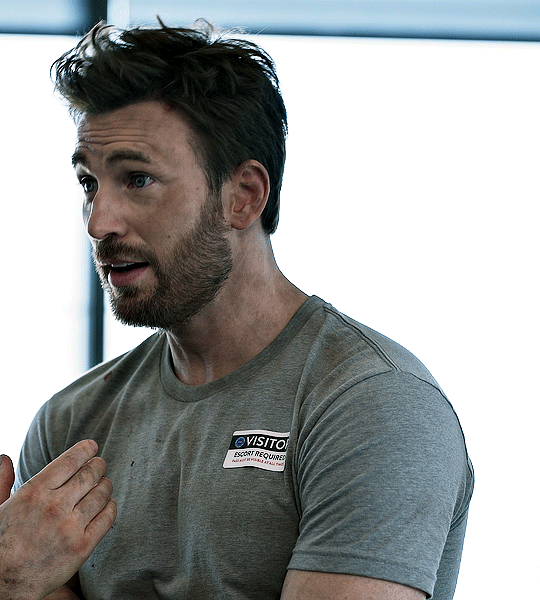

Ari Levinson


Aladdin. Released on November 25, 1992. This is one of my favorite Robin Williams movies.
Aladdin reminds Ari of the time he once ran a resort. He now runs an import business, and some of the imports take him back to that place. He was also a geography teacher, and he would always talk about the time he once ran a resort when the kids studied and learned about the Red Sea, and the countries that surround it.
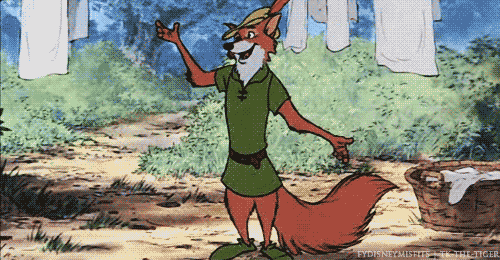
Robin Hood. Released on November 8, 1973. Ari, Zachary and Elijah love this one. The boys can't understand how a fox is Robin Hood, but they love it. The boys are currently into animals, so they love movies that have anything to do with animals. Robin Hood is also their favorite story.
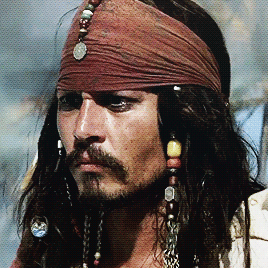
Pirates of the Caribbean: The Curse of the Black Pearl. Released on June 28, 2003. Ari loves this because Pirates of the Caribbean is his favorite Disney ride, and with him running his import business and the resort he ran, this hits a soft spot with him.

Th Fox and the Hound. Released on July 10, 1981. This is another favorite with the Zachary and Elijah. Ari loves this one, too. It isn't strange for your three favorite guys to watch this movie, with a huge bowl of popcorn between the three of them, lemonades, and all of them curled up under a blanket, watching this movie. The boys even like to watch when they're sick.

Lady and the Tramp. Released on June 22, 1955. This is Lillian's favorite. It's also a favorite of the boys. You put this on when Lillian would be teething, and she'd somehow forget about her teething pains. Zachary and Elijah and Lillian all watch this on movie night.

Sleeping Beauty. Released on January 29, 1959. Ari has a soft spot for this one. This is his sister Andrea loved this one, and would often dress up as Aurora on Halloween. Lillian loves this one, too. It's another movie that you put on that helps her through teething pains. Ari and the boys get Lillian an Aurora stuffed doll for her first birthday.

Zootopia. Released on March 4, 2016. Zachary, Elijah, Lillian, Ari and you love this one. The kids love animals, and they'll always pick out this one on family movie night. It's gender neutral enough where the boys enjoy it, and Lillian enjoys it.

Frank Adler


Cars. Released on June 9, 2006. Frank is a mechanic, so this movie makes sense for him. He loves it.

Moana. Released on November 23, 2016. Mary loves this one. She's not sure why, though. Frank loves this one, too. He works with boats, and loves being near the water.
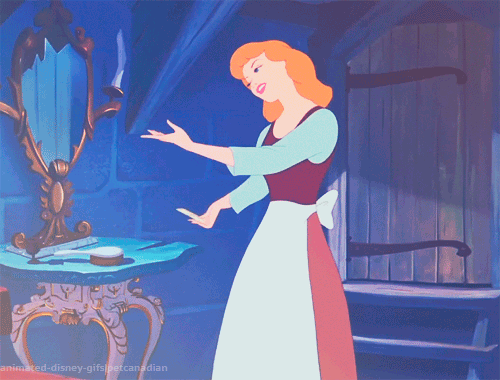
Cinderella. Released on March 4, 1950. Mary loves this because she's treated less than. She just wants to feel beautiful even if it's just for one day.


#chris evans#team chris#chris evans fandom#pete brenner#tangled movie#rapunzel#mary poppins#petes dragon#peter pan#disney movies#cole turner#the sword in the stone#the rescuers#the rescuers down under#john candy#sctv#ari levinson#aladdin#robin williams#pirates of the caribbean#robin hood#the fox and the hound#lady and the tramp#sleeping beauty#zootopia#frank adler#cars#moana#cinderella
5 notes
·
View notes
Text
Now I'm thinking about which comics titles I've read and what I'd recommend to people jumping into DC comics. These are all in the Post-Crisis Pre-Flashpoint era, so not only are they finished running, the universe they're in is closed too.
Robin minis I, II, III: 15 issues total, from 1991 - 1993.
Establishing character stories for Tim Drake as Robin, with some interesting geo-political time capsule elements because they're all from the very early 1990's. This is when Tim is a relatively new vigilante, and each story has a reason for Batman to be mostly out of the picture so we see what Tim is like by himself, rather than as Batman's Partner. Spoiler: Tim by himself will always find people to team up with, and not just other capes! Very much plays into the struggles of having a double life.
Also serves as a good introduction to the city of Gotham & the crime stories the Bats handle, covering the mafia, international organizations, and various levels of Rogues.
Young Justice 1998: 55 issues, 1998 - 2003.
Fun ensemble cast, whacky adventure stories, with a solid emotional core running through it. In an era when more adult oriented comics were trying for realism by going Grim & Gritty, Young Justice said "How about we tackle realistic Teen Issues by putting them in the zany shenanigans that the golden/silver age would've had?"
This can create some mood whiplash, but also really works. Probably because that's often what being a teenager is like.
Batgirl 2000: 73 issues, 2000- 2006.
Speaking of what being a teenager is like, Cassandra Cain's Batgirl run my beloved. Lots of snark. Both Cass and her primary mentor are disabled women, and though Cass's disability is based on Comics Logic, it's internally consistent for the story, and her illiteracy has real effects on the plot and her life. Coming of age story, gifted kid burnout, the lengths you'll go to to get being the best back, wrestling with guilt, heroism, & self-worth.
Cass has a language disability and is one of the deadliest physical fighters in the world. Her mentor Barbara Gordon is paraplegic, a librarian, and information specialist. They have some shared experiences and values, and some wildly different experiences and values, and they clash! They care about each other deeply! They tease each other! Barbara fucks up sometimes, and also sincerely apologizes when she does.
Huntress: Cry For Blood: 6 issues, published in 2000.
Solid short noir mystery & rehash of Helena's origin story. Has a very poetic vibe. I was able to follow it after only seeing Helena in crossovers rather than reading her solo series.
~
I got the number of issues from the fanwikis, and should note that Young Justice & Batgirl issue count does not include crossover events, where issues in other titles may be needed for the full story. I found Batgirl mostly understandable without reading the crossovers, but with Young Justice I needed to either track the issues down or search fanwikis for context.
What are some titles or story arcs you all recommend?
#DC#Min reads Comics#Young Justice 1998#Batgirl 2000#Robin I#Robin II#Robin III#Huntress Cry For Blood
11 notes
·
View notes
Text
FEATURES
HIP-HOP’S GREATEST ROAD TRIP SONGS
By Stereo Williams
Published Fri, August 14, 2020 at 11:00 AM EDT
The global coronavirus pandemic has led to so many having to spend hours upon hours stuck inside. The effect of widespread quarantining means many are feeling stifled and sequestered in their homes. And it's so unfortunate, because the road can be therapeutic. Cruising can hold a unique spiritual freedom; getting behind the wheel can be as close as many of us get to "getting away from it all." The only thing better than hopping in the car and riding to nowhere is having a great soundtrack to push things along. Songs about the open road are a great American tradition – from “Rocket 88” to “Freeway of Love.” In Hip-Hop, those songs convey a sense of freedom and identity, beyond just the allure of hitting the highway, there’s also the sense of self that comes from riding around the neighborhood, speakers blaring, rims spinning. Whether long drives, or slowly rollin' the streets on a Sunday—these are some classic rap road songs that you'd have on deck.
FOR THE RIDERS: ALL-PURPOSE ANTHEMS
“MY HOOPTIE” – SIR MIX-A-LOT (1989)
As Hip-Hop became more obsessed with flashy, luxury vehicles, it’s sometimes great to think back to when it was cool to rap about the kind of junker we all had to push at some point or another.
There’s no better ode to the lemon than Mix-A-Lot’s classic “My Hooptie,” featuring an always broken windshield, non-working meters and dragging tailpipe. Sir Mix-A-Lot had a knack for story raps about cruising with his boys, and while “Posse On Broadway” might be more beloved, “My Hooptie” is the quintessential everyman car song. We’ve all had this car.
“24S” – T.I. (2003)
Tip has a few songs that define the early 2000s, and “Top Back” is another car banger that could have easily been on this list. But it was this ode to bigass rims that helped set things off for Clifford Harris’ early career, and the hook is one of his best.
Produced by DJ Toomp, it perfectly captures ATL swagger and the car culture that defines so much of southern rap from Miami to Atlanta to Houston. And T.I. is on one throughout the track. “I'm in a drop-top Chevy with the roof wide open/My partners looking at me to see if my eyes open/Cause I've been dranking and I've been smoking…” A ridin’ masterpiece.
RIDIN' - CHAMILLIONAIRE FEAT. KRAYZIE BONE (2005)
The thrill of driving is as American as apple pie — but the reality of “Driving While Black” is just as inherent in the experience of so many young Black people. This classic hit from Chamillionaire illustrates the duality of both: it’s an undeniable car classic that also functions as a harrowing tale of how just being a brotha cruising in your ride can lead to an altercation with the cops.
The Texas rapper was inspired by UGK’s classic 1996 album, and with a heavy assist from Krayzie, Cham makes it clear that, for certain folks, there is no easy liberation to be found in going for a ride in the whip. But he also couches that message in a song that functions as perfect car music. Quite a trick to pull off.
DROP YOUR EMAIL
TO STAY IN THE KNOW
SUBMIT
Block Bangers for Urban Road Warriors
0 seconds of 0 seconds
“YOU’RE GONNA GET YOURS” – PUBLIC ENEMY (1987)
P.E.’s first album is bombastic and aggressive, but it may surprise younger listeners with how it’s not quite as focused on righteous, raging rhetoric as their later, more famous works.
The clearest example of Chuck D’s early approach is this car-themed classic. Often casually referred to as “My ’98 Oldsmobile” it features Chuck rhyming over an almost Run-DMC-esque truck rattling beat courtesy of the Bomb Squad, where he makes his Olds sound like an urban terrain vehicle made for b-boys. He rhymes about his ride as if it’s his only protection against the suckas hatin.’ Tell me you can’t relate. Perfect anthem for any road warrior.
0 seconds of 0 seconds
“THE BOOMIN’ SYSTEM” – LL COOL J (1990)
LL COOL J was blanking out throughout Mama Said Knock You Out, a classic album with no shortage of bangers. But this car anthem classic made it clear that James Todd Smith knew a thing or three about having a dope-ass system in your car. A sentiment that resonated with heads from Queens to Cali, LL perfectly tapped into the energy of riding around with the system loud as hell.
“LET’S RIDE” – Q-TIP (1999)
The former A Tribe Called Quest frontman’s solo debut Amplified may be most remembered for shiny pop singles like “Breathe & Stop” and the ubiquitous “Vivrant Thing,” but it was this chill ode to riding in your whip that best crystalizes who Kamal Fareed was going to be circa Y2K.
Name-dropping the classic rock of The Who alongside the Hip-Hop du jour of Biggie, Q-Tip makes a perfect case for rolling to the sounds of your choice and not letting the outside world interrupt the groove.
IMPALA ANTHEMS: FOR SITTIN’ SIDEWAYS ON A SOUTHERN SLAB
“DRIVE SLOW” – KANYE WEST FEAT. PAUL WALL (2005)
‘Ye was in full bloom on Late Registration, and this Paul Wall-assisted, southern-flavored tribute to riding was one of the standouts on an album that many still consider Yeezy’s best. Over an inspired Hank Crawford sample, ‘Ye and Wall rap about car culture as a metaphor for life, and Wall almost missed the session.
“I got pulled over on the way to the studio,“ he said in 2016. "My driver made a right turn from the wrong lane. “I said, ‘Hell nah. This ain’t real.’ I cussed the police out thinking I was getting ‘Punk’d. I almost ain’t make it.”
The remix featured a verse from T.I. and the video is an orgy of dope cars. “That verse was actually the first verse that I wrote when I was writing ‘Sittin’ Sidewayz,'” explained Paul. “Back in those days, I didn’t know how to harness the power of the production sometimes.” In the end, he decided that those rhymes were “hard” but, “Didn’t really go hand-in-hand with that beat.”
0 seconds of 0 seconds
“LACVILLE ’79” – DEVIN THE DUDE (2002)
Devin is Hip-Hop’s most laconic storyteller; like a laid-back cousin who tells stories better than anybody else in the family. His classic single breaks down the joys of having a car that’s all your own — warts and all.
Like Mix-A-Lot’s “My Hooptie,” this is an ode to a car that we all have owned at some point, and it’s the perfect anthem for hitting the road on a lazy afternoon or two. It also wouldn’t hurt to have a doobie in the ashtray — not that anyone’s advocating that sort of thing.
“STILL TIPPIN’” – MIKE JONES FEAT. PAUL WALL AND SLIM THUG (2004)
It’s slow as syrup and perfectly encapsulates Houston’s car culture in a genre-defining four and a half minutes. Mike Jones never quite topped his debut single, a tribute to chopped-and-screwed sound of DJ Screw and to a uniquely Texas flavor of rap that had been a part of southern rap since the early 1990s.
The whole song is a dedication to cruising, and of course "tippin' on four 4s, wrapped in four Vogues." It dropped the Houston sound smack dab into the middle of the mainstream, made stars out of Paul Wall and Slim Thug — and ensured that no one would have to ask “Who is Mike Jones?” ever again.
LOWRIDER LEANING: CLASSICS FOR CALI CRUISIN’...
0 seconds of 0 seconds
“LET ME RIDE” – DR. DRE (1993)
The good Doctor’s G-Funk classic perfectly captures the essence of The Chronic and the feel of So Cal cruising. Even if you’ve never seen Crenshaw and Slauson, the slice of laid-back Cali cool puts you right there. The gunplay and tough talk are there, but take a backseat to the feel good vibe of rollin’ in ya 64, a sentiment that anyone can relate to who has ever gone for a Sunday road trip on a gorgeous day.
“HIGH TIL I DIE” – 2PAC (1996)
This song isn’t exactly about a car or about driving, but it perfectly captures a certain feel associated with carefree cruising when you got nowhere to go. Like a lot of Pac anthems, the freewheeling feel belies lyrics that warn of danger at every turn — even while sounding unaffected (“When I'm in traffic, it's kinda rough and, I drive a bucket, Live the Thug Life nigga – screaming ‘fuck it’”). It’s quintessential Pac, and a perfect thug anthem for a ride.
“JEEP ASS NIGUH/BORN TO ROLL” – MASTA ACE (1993, 1994)
Former Juice Crewer and Brooklyn legend Masta Ace became a somewhat unlikely advocate for Hip-Hop car culture in the mid-1990s. The rhyme animal semi-reinvented himself as a cruise anthem rapper with hits like this. Of course, “Jeep Ass Niguh” first appeared in 1993s Slaughterhouse before it was reinvented as the decidedly West Coast-leaning “Born To Roll” a year later. It gave Ace one of his biggest crossover hits and came to define car songs that Cali loved in the 1990s. He would dive headfirst into the sound on 1995s Sittin’ On Chrome, but this was his first foray into such subject matter — and still his best.
* HEADER CREDIT: Dr. Dre and Fab 5 Freddy during 1993 MTV Video Music Awards at Universal Amphitheater in Los Angeles, California. (Photo by Jeff Kravitz/FilmMagic, Inc)
WHAT'S NEW
NEWSPOSITIVE K'S NEW VENTURE: STAND-UP COMEDYNEWSLORD FINESSE HOSTS A SAMPLING MASTER CLASSNEWSCHUCK D, ICE CUBE HONOR ICE-T AS HE RECEIVES STAR ON THE HOLLYWOOD WALK OF FAMENEWS'RAP TRAP: HIP-HOP ON TRIAL' DOCUMENTARY FEATURES KILLER MIKE, FAT JOE, AND MORE
WEBSITE
NEWS
VIDEOS
ICONS
SHOP
ABOUT
PARTNERSHIPS
SHIPPING & RETURNS
NEWSLETTER
Sent from my iPhone
2 notes
·
View notes
Text
Unparalleled Journey of Celine Dion: A Musical Icon
When it comes to icons in the music industry, few names shine as brightly as Celine Dion. With a career spanning over four decades, Celine Dion has captivated audiences worldwide with her powerful voice, emotional performances, and timeless hits. Here, we take a closer look at her incredible journey and the enduring legacy she continues to build.
Read More HERE
Early Life and Beginnings
Celine Dion was born on March 30, 1968, in Charlemagne, Quebec, Canada. The youngest of 14 children, her talent was evident from a young age. With the support of her family, Celine began performing in her parents' piano bar and quickly caught the attention of René Angélil, who would become her manager and later her husband.
Rise to Stardom
Celine's big break came when she won the 1988 Eurovision Song Contest, representing Switzerland. This victory propelled her to international fame and set the stage for a series of successful albums and singles. Her 1990 album, Unison, marked her breakthrough in the English-speaking market, but it was her 1996 album, Falling into You, that solidified her status as a global superstar.
Iconic Hits and Unforgettable Performances
Celine Dion's discography is a treasure trove of iconic hits. Songs like "The Power of Love," "Because You Loved Me," and "It's All Coming Back to Me Now" have become anthems for millions. However, it was her rendition of "My Heart Will Go On," the theme song for the blockbuster movie Titanic, that became her signature song and earned her worldwide acclaim.
Her live performances are equally legendary. Known for her powerful stage presence and vocal prowess, Celine's concerts are unforgettable experiences. Her Las Vegas residency, which began in 2003, set new standards for live entertainment and was attended by millions over its 16-year run.
Personal Life and Resilience
Celine's personal life has been marked by both joy and tragedy. Her deep bond with René Angélil, who passed away in 2016, was a central part of her life and career. Despite personal losses and challenges, Celine has shown remarkable resilience, continuously inspiring fans with her strength and dedication.
Legacy and Influence
Today, Celine Dion remains a beloved figure in the music world. Her influence extends beyond her vocal talent, as she has become a fashion icon and a symbol of perseverance. Her music continues to resonate with new generations, and her contributions to the industry are celebrated worldwide.
In conclusion, Celine Dion's journey from a small-town girl in Quebec to an international music icon is nothing short of extraordinary. Her voice, passion, and resilience have left an indelible mark on the world, making her one of the most cherished artists of our time. For more on Celine Dion and her latest endeavors, visit JustBaazaar.
0 notes
Text
The 35 Most Memorable Chick Flicks and Rom-Coms of All Time

Dish Network has compiled a list of the 35 most memorable chick flicks and rom coms of all time, featuring a mix of classic favorites and contemporary hits. These films have left a significant mark on audiences with their heartwarming stories, memorable quotes, and standout performances. Here's a glimpse into some of the highlights from their list:
Classic Romantic Comedies
1. My Big Fat Greek Wedding (2002)
This film centers around a woman's journey of self-discovery and her struggle to balance her cultural heritage with her own desires. Known for its quirky characters and the famous Windex remedy, it’s a heartwarming tale of family and love.
2. Kate & Leopold (2001)
A charming blend of romance and time travel, this movie stars Meg Ryan and Hugh Jackman. It's remembered for its whimsical storyline and delightful performances, making it a must-watch for fans of romantic comedies.
3. How to Lose a Guy in 10 Days (2003)
Featuring Kate Hudson and Matthew McConaughey, this film follows the antics of two people making bets that interfere with their relationship. It's filled with humor, romantic tension, and memorable moments like the "You're So Vain" karaoke scene.
4. Sweet Home Alabama (2002)
Reese Witherspoon shines in this story about a Southern girl turned New York socialite who returns to her roots. The film is loved for its Southern charm, romance, and the iconic scene of Witherspoon's character in a Civil War reenactment.
Tear-Jerkers
1. Titanic (1997)
James Cameron's epic romance set against the backdrop of the ill-fated Titanic voyage stars Leonardo DiCaprio and Kate Winslet. Known for Celine Dion’s "My Heart Will Go On" and the debate over the floating door, it remains a staple of romantic cinema.
2. Moulin Rouge! (2001)
This visually stunning musical features Ewan McGregor and Nicole Kidman in a tragic love story. Its unforgettable soundtrack and Baz Luhrmann's unique directorial style make it a standout film in the genre.
3. P.S. I Love You (2007)
After her husband’s death, a young widow (Hilary Swank) discovers a series of letters he left behind to help her move on. This film poignantly explores grief and recovery, making it a beloved tear-jerker.
Modern Favorites
1. About Time (2013)
This charming film blends romance and time travel, telling the story of a young man who can travel back in time to improve his love life. It's celebrated for its touching father-son relationship and heartwarming narrative.
2. The Big Sick (2017)
A contemporary romance that deals with cultural differences and medical crises, starring Kumail Nanjiani and Zoe Kazan. It's a fresh and heartfelt film based on Nanjiani's real-life romance.
3. 500 Days of Summer (2009)
Starring Joseph Gordon-Levitt and Zooey Deschanel, this film takes a realistic look at love and heartbreak through the lens of a young man's memories of a failed relationship. It's noted for its nonlinear storytelling and memorable scenes like the "You Make My Dreams" dance sequence.
Classic Romance Films
1. The Princess Bride (1987)
A fairy tale adventure that combines romance, humor, and action. Known for iconic lines like "As you wish" and "Hello, my name is Inigo Montoya," it’s a timeless favorite.
2. Pretty Woman (1990)
This modern Cinderella story starring Julia Roberts and Richard Gere is remembered for its charming love story and Roberts' breakout performance. The "Big mistake! Huge!" scene is particularly iconic.
3. Dirty Dancing (1987)
A summer romance between a dance instructor (Patrick Swayze) and a young woman (Jennifer Grey) at a resort. Famous for the "Nobody puts Baby in a corner" line and the climactic dance scene to "I've Had the Time of My Life."
Female Friendship Films
1. Mean Girls (2004)
This high school comedy, written by Tina Fey and starring Lindsay Lohan, explores the dynamics of teenage cliques and friendships. Known for its witty dialogue and memorable quotes like "On Wednesdays we wear pink."
2. Legally Blonde (2001)
Reese Witherspoon stars as Elle Woods, a sorority girl who challenges stereotypes by excelling at Harvard Law School. It's a fun, empowering film with a standout performance by Witherspoon.
3. Bridesmaids (2011)
Kristen Wiig and Maya Rudolph lead this hilarious film about the ups and downs of being a maid of honor. The film is praised for its comedic take on friendship and the unforgettable bridal shop scene.
These films have become beloved parts of pop culture, offering audiences a mix of laughter, tears, and memorable moments. Whether you're revisiting a classic or discovering a new favorite, these chick flicks and rom coms are sure to leave a lasting impression (US DISH) (IMDb).
#dish network packages#dish network installation#dish packages seniors#dish network outages#dish similar companies#dish network deals#dish network remote codes#satellite tv company
0 notes
Photo
And even more for the list below the cut because I accidentally deleted the original list, to be regularly updated:

The Bronze Buckaroo (1939)
Lady from Louisiana (1941)
Savage Pampas (1945)
Native Son (1951)
The Tall Target (1951)

The Landowner's Daughter (1953)
El Grito Sagrado (1954)
Tamango (1958)
Porgy and Bess (1959)

Ganga Zumba (1963)
Lola Colt (1967)
The Great White Hope (1970)

Lady Sings the Blues (1972)
Sounder (1972)
Buck and the Preacher (1972)
The Autobiography of Miss Jane Pittman (1974)

Thomasine & Bushrod (1974)

Arabian Nights (1974)
Mandingo (1975)
Salò, or the 120 Days of Sodom (1975)

Xica (1976)

Sparkle (1976)

Roots (1977)

Ribo ou le soleil sauvage (1978)
A Woman Called Moses (1978)
West Indies (1979)
Freedom Road (1979)
Roots: The Next Generations (1979)
Backstairs at the White House (1979)

Manganinnie (1980)

Quest for Fire (1981)
Women of the Sun (1981)
Ragtime (1981)
Sugar Cane Alley (1983)
For Us the Living: The Medgar Evers Story (1983)
Cross Creek (1983)

Quilombo (1984)
Solomon Northup's Odyssey (1984)
The Killing Floor (1984)
The Jesse Owens Story (1984)

The Cotton Club (1984)
Silverado (1985)

Shaka Zulu (1986)
Native Son (1986)
Little Shop of Horrors (1986)
Sarraounia (1986)

Yeelen (1987)

Angel Heart (1987)
Uncle Tom's Cabin (1987)

Harlem Nights (1989)
Erik the Viking (1989)
The Mahabharata (1989)
The Women of Brewster Place (1989)

Tilaï (1990)
The Long Walk Home (1990)
Brewster Place (1990)

The Josephine Baker Story (1991)

Daughters of the Dust (1991)
Fried Green Tomatoes (1991)

Malcolm X (1992)
The Jacksons: An American Dream (1992)
Sarafina! (1992)
What's Love Got to Do with It (1993)
Queen (1993)
Posse (1993)
Sankofa (1993)
Great Moments in Aviation (1993)
Corrina, Corrina (1994)
The Flintstones (1994)
Oldest Living Confederate Widow Tells All (1994)
Witch Hunt (1994)

Guimba the Tyrant (1995)
Jefferson in Paris (1995)
A Little Princess (1995)
Solomon & Sheba (1995)

Devil in a Blue Dress (1995)
The Journey of August King (1995)

Xica da Silva (1996)
The Final Passage (1996)

The Cherokee Kid (1996)
Gulliver's Travels (1996)
Mr. and Mrs. Loving (1996)
Once Upon a Time... When We Were Coloured (1996)

Eve’s Bayou (1997)
Rodgers and Hammerstein's Cinderella (1997)
Hoodlum (1997)
Mama Flora's Family (1997)
Boogie Nights (1997)
Miss Evers' Boys (1997)
True Women (1997)
Rosewood (1997)

Beloved (1998)
Ruby Bridges (1998)
Why Do Fools Fall in Love (1998)
Peggy Su! (1998)
Having Our Say: The Delany Sisters' First 100 Years (1999)

Introducing Dorothy Dandridge (1999)
Selma, Lord, Selma (1999)
Annie (1999)
Unbowed (1999)
Deep in My Heart (1999)
Girl, Interrupted (1999)
A Lesson Before Dying (1999)
Liberty Heights (1999)
Força de um Desejo (1999-2000)

Lumumba (2000)
Love's Labour's Lost (2000)
Remember the Titans (2000)
The Colour of Friendship (2000)
Sally Hemings: An American Scandal (2000)
Feast of All Saints (2001)
The Old Settler (2001)
Ali (2001)
Bojangles (2001)

A Samba for Sherlock (2001)
Shaka Zulu: The Citadel (2001)
Boycott (2001)

Asterix & Obelix: Mission Cleopatra (2002)

O Quinto dos Infernos (2002)
Chicago (2002)

Rabbit-Proof Fence (2002)
The Rosa Parks Story (2002)

8 Women (2002)
Far from Heaven (2002)
Esperança (2002-2003)

Monsieur Ibrahim (2003)
Wondrous Oblivion (2003)
The Royal (2003-2011)
Kubanacan (2003-2004)
Salem Witch Trials (2003)

Pirates of the Caribbean: The Curse of the Black Pearl (2003)

Chocolate com Pimenta (2003-2004)

Hotel Rwanda (2004)
Jack Paradise: Montreal by Night (2004)
Um Só Coração (2004)

Ray (2004)
Brother to Brother (2004)

Vanity Fair (2004)
Alexander (2004)
Something the Lord Made (2004)

Iron Jawed Angels (2004)
Lackawanna Blues (2005)
Roll Bounce (2005)

Casanova (2005)
Their Eyes Were Watching God (2005)

Pirates of the Caribbean: Dead Man's Chest (2006)

Sinhá Moça (2006)
Wide Sargasso Sea (2006)
Idlewild (2006)

Mad Men (2007–2015)

Oliver Twist (2007)
Talk to Me (2007)
Zorro, La Espada y la Rosa (2007)

September (2007)
Pride (2007)
American Gangster (2007)
Hounddog (2007)

Hairspray (2007)

Murdoch Mysteries (2008-)
Merlin (2008-2012)

Skin (2008)
A Raisin in the Sun (2008)
La Traición (2008)

Little Dorrit (2008)
Kit Kittredge: An American Girl (2008)
The Curious Case of Benjamin Button (2008)

A Ilha dos Escravos (2008)

Bran Nue Dae (2009)
Mississippi Damned (2009)
Gifted Hands: The Ben Carson Story (2009)
Notorious (2009)
Precious (2009)

Children of the Corn (2009)
Black Dynamite (2009)

The Assailant (2009)
The Nativity (2010)

Mrs. Mandela (2010)

Boardwalk Empire (2010-2014)
Love's Labour's Lost (2010)
Spartacus (2010-2013)
Frankie & Alice (2010)

Black Venus (2010)
Shirley (2011)
Black Gold (2011)
The Awakening (2011)
X-Men: First Class (2011)
The Playboy Club (2012)

Endeavour (2012-2023)

Lado a Lado (2012)

Django Unchained (2012)

Call the Midwife (2012-)
Hotel Noir (2012)

Toussaint Louverture (2012)
Hannah's Law (2012)

Treasure Island (2012)

Mabo (2012)
Julius Caesar (2012)
Lincoln (2012)

O Inventor de Sonhos (2012)

Sparkle (2012)
Copper (2012-2013)

Sinbad (2012)
Adesuwa (2012)

The Sapphires (2012)

The Price of Sugar (2013)

Betty and Coretta (2013)
Burton & Taylor (2013)
Njinga: Queen Of Angola (2013)
Tula: The Revolt (2013)
The Bible (2013)
Half of a Yellow Sun (2013)
César Chávez (2013)

Da Vinci's Demons (2013-2015)
1982 (2013)
42 (2013)
The Outlaw Michael Howe (2013)
The Carrie Diaries (2013-2014)
12 Years a Slave (2013)
The Sound of Music Live! (2013)
Jimi: All Is by My Side (2013)
Black Girl in Paris (2013)

They Die by Dawn (2013)

The Butler (2013)

Mandela: Long Walk to Freedom (2013)
Masters of Sex (2013-2016)
Mr Selfridge (2013-2016)

Dancing on the Edge (2013)

Strange Empire (2014)
Salem (2014-2017)
Pompeii (2014)

Grantchester (2014-)
Get on Up (2014)
Northern Soul (2014)
The Knick (2014-2015)

Crossbones (2014)
Sweeney Todd: The Demon Barber of Fleet Street (2014)

The Musketeers (2014-2016)
Outlander (2014-)
The Keeping Room (2014)
Hieroglyph (2014)

Turn: Washington's Spies (2014-2017)

Palm Trees in the Snow (2015)

Still A Rose (2015)
Born to Be Blue (2015)

Texas Rising (2015)

A.D. The Bible Continues (2015)
The Book of Negroes (2015)
Hetty Feather (2015-2020)
Whitney (2015)
Danny and the Human Zoo (2015)

Iyore (2015)
Good Girls Revolt (2015-2016)
Miles Ahead (2015)
Jekyll and Hyde (2015)
Tut (2015)

The Ark (2015)

Celia (2015-2016)

Poldark (2015-2019)

Pelé: Birth of a Legend (2016)

Of Kings and Prophets (2016)

The Legend of Tarzan (2016)
Fantastic Beasts and Where to Find Them (2016)
A United Kingdom (2016)

Bodo (2016)
The Birth of a Nation (2016)
'76 (2016)

An American Girl Story – Melody 1963: Love Has to Win (2016)
Close to the Enemy (2016)
Upstart Crow (2016-)
Sophie and the Rising Sun (2016)
Roots (2016)

Liberdade, Liberdade (2016)
Mercy Street (2016-2017)
Lady Macbeth (2016)

Fences (2016)
Azúcar (2016)
The Nice Guys (2016)

Cheating Husband (2016)

Êta Mundo Bom! (2016)
Lady Day at Emerson's Bar and Grill (2016)
Loving (2016)

Underground (2016-2017)

Escrava Mãe (2016)

Free State of Jones (2016)

Velho Chico (2016)

Pambelé (2017)
The Greatest Showman (2017)
1745 (2017)

Novo Mundo (2017)
Double Play (2017)
Gook (2017)
Guerrilla (2017)
White Gold (2017-2019)

Mudbound (2017)
Howards End (2017)

The Good Time Girls (2017)
Timewasters (2017-2018)

The Shape of Water (2017)

Sweet Country (2017)

Black Holler (2017)
The French Dream (2017-2018)
The Adventures Of Selika (2017)

Anne with an E (2017-2019)

Frankie Drake Mysteries (2017-2021)
Taboo (2017)
The Immortal Life of Henrietta Lacks (2017)
GLOW (2017-2019)
A Christmas Story Live! (2017)
Still Star-Crossed (2017)
Genius (2017)

Roxanne Roxanne (2017)
The Chosen (2017-2023)

Mindhunter (2017-2019)

The Nutcracker and the Four Realms (2018)
The Alienist: Angel of Darkness (2018-2020)

The Long Song (2018)
The Miseducation of Cameron Post (2018)
The Little Drummer Girl (2018)

BlacKkKlansman (2018)
Central & Broadway (2018)

Les Misérables (2018)
Ordeal by Innocence (2018)
Happy Birthday, Marsha! (2018)
Flock of Four (2018)
If Beale Street Could Talk (2018)

Vita & Virginia (2018)
Wrong Kind of Black (2018)
Where Hands Touch (2018)
Luis Miguel: The Series (2018-2021)

Bad Times at the El Royale (2018)
In the Long Run (2018-2020)

Picnic at Hanging Rock (2018)

The Nightingale (2018)

Fantastic Beasts: The Crimes of Grindelwald (2018)

Coisa Mais Linda (2019-2020)

Sanditon (2019-)
World on Fire (2019-)
Dumbo (2019)
The Best of Enemies (2019)

Godfather of Harlem (2019)
Gentleman Jack (2019-2022)

Carnival Row (2019-2023)
Salacia (2019)

Motherless Brooklyn (2019)
Year of the Rabbit (2019)

Our Lady of the Nile (2019)

The Personal History of David Copperfield (2019)

The Spanish Princess (2019-2020)
Scary Stories to Tell in the Dark (2019)
Bolden (2019)
Wu-Tang: An American Saga (2019-2023)
A Christmas Carol (2019)
American Horror Story: 1984 (2019)
Dickinson (2019–2021)
Black Monday (2019-2021)
When They See Us (2019)

The Kitchen (2019)

Mixed-ish (2019-2021)
Dolemite Is My Name (2019)

For All Mankind (2019-)
Seberg (2019)

Sydney to the Max (2019-2021)

Hollywood (2020)

Come Away (2020)

Bridgerton (2020-)

Enola Holmes (2020)

Lovecraft Country (2020)

Misbehaviour (2020)

The Queen's Gambit (2020)
Perry Mason (2020-2023)
Lovers Rock (2020)

Cursed (2020)
The Glorias (2020)

Miss Scarlet and The Duke (2020-)
Mangrove (2020)

The 24th (2020)

High Ground (2020)
Deutschland 89 (2020)
Emperor (2020)

Mrs America (2020)
The Pale Horse (2020)

Ma Rainey's Black Bottom (2020)
The Legend of Inikpi (2020)

Sylvie’s Love (2020)

Bad Hair (2020)
Hamilton (2020)
Education (2020)
Son of the South (2020)

The Banker (2020)
Red, White and Blue (2020)
One Night in Miami... (2020)

Hunters (2020–2023)

Summerland (2020)

Operation Buffalo (2020)

The Haunting of Bly Manor (2020)

Richard II (2020)

Little Fires Everywhere (2020)

The Witches (2020)
The Secret Garden (2020)
Uncle Vanya (2020)
Agatha and the Midnight Murders (2020)

Roald & Beatrix: The Tail of the Curious Mouse (2020)

The Green Knight (2021)

Last Train to Christmas (2021)

The Power (2021)

Cruella (2021)

West Side Story (2021)

The Nevers (2021)
Respect (2021)

The Harder They Fall (2021)
King Richard (2021)
Judas and the Black Messiah (2021)

Doutor Gama (2021)

Anne Boleyn (2021)

Passing (2021)

Fear Street Part One: 1994 (2021)
Tick, Tick... Boom! (2021)
Annie Live! (2021)
The Colour Room (2021)
The Tragedy of Macbeth (2021)

Cruel Summer (2021-)

The Wonder Years (2021-)

The Underground Railroad (2021)

Schmigadoon! (2021-)
Them (2021)
Robin Roberts Presents: Mahalia (2021)

The Drover's Wife (2021)

The United States vs. Billie Holiday (2021)

Domina (2021-)

The Confessions of Frannie Langton (2022)

Bones and All (2022)

Death on the Nile (2022)
The Serpent Queen (2022-)
Remember Me: The Mahalia Jackson Story (2022)
Amsterdam (2022)

Vikings: Valhalla (2022-)
Trees of Peace (2022)
The Walk (2022)
The Outfit (2022)

Enola Holmes 2 (2022)

Catherine, Called Birdy (2022)
Hotel Portfino (2022-)
Mrs Harris Goes To Paris (2022)
Persuasion (2022)
Don't Worry Darling (2022)
Where the Crawdads Sing (2022)
The King's Daughter (2022)
A Jazzman’s Blues (2022)

Interview with the Vampire (2022-)

The Woman King (2022)

Alice (2022)

Aníkúlápó (2022)
Dangerous Liaisons (2022)

Freedom’s Path (2022)

Fantastic Beasts: The Secrets of Dumbledore (2022)

Minx (2022-)
Candy (2022)

Our Flag Means Death (2022-)

A League of their Own (2022)
Mr. Malcolm's List (2022)
Call Jane (2022)
The Silent Twins (2022)
Emancipation (2022)
See How They Run (2022)

Whitney Houston: I Wanna Dance with Somebody (2022)

The Gilded Age (2022-)
Women of the Movement (2022)

The Porter (2022)
Elvis (2022)

Pinocchio (2022)

Paper Girls (2022)

Till (2022)

Three Thousand Years of Longing (2022)
Fannie (2022)

Willow (2022)
Beauty and the Beast: A 30th Celebration (2022)

Kindred (2022)
Holy Family (2022)

Chevalier (2022)

That ’90s Show (2023)

Spinning Gold (2023)

Air (2023)
Great Expectations (2023)
King Shaka (2023)
Nolly (2023)
African Queens (2023-)

Daisy Jones & the Six (2023)
Funny Woman (2023)

Big George Foreman (2023)

My Animal (2023)
The Roar of the Butterflies (2023)

Queen Charlotte: A Bridgerton Story (2023)

Grease: Rise of the Pink Ladies (2023)
A Town Called Malice (2023)

The Little Mermaid (2023)
Tetris (2023)
Transatlantic (2023)
Shaka iLembe (2023)
The Crowded Room (2023)

Tom Jones (2023)
The Gallows Pole (2023)

Peter Pan and Wendy (2023)

Surrounded (2023)
Rustin (2023)
Black Cake (2023)
Nome (2023)

The Buchaneers (2023)
Lessons in Chemistry (2023)
Queen Cleopatra (2023)
Poor Things (2023)
The Artful Dodger (2023-)
Fellow Travelers (2023)
The Colour Purple (2023)
Lawmen: Bass Reeves (2023)

Ordinary Angels (2023)

The Book of Clarence (2023)
The Holdovers (2023)

Indiana Jones and the Dial of Destiny (2023)
Three Little Birds (2023)
The Winter King (2023)

The New Boy (2023)
Origin (2023)

Sense and Sensibility (2024)
Love Lies Bleeding (2024)
Upcoming
Bob Marley: One Love (2024)
Palm Royale (2024)
Shirley (2024)
The Count of Monte Cristo (2024)
How to Train Your Dragon (2025)
Lady in the Lake (TBA)
The Big Cigar (TBA)

Dark Harvest (TBA)

Six Triple Eight (TBA)
The Nickel Boys (TBA)
Manhunt (TBA)
The Extraordinary Farewell (TBA)
Seacole (TBA)
Wicked Little Letters (TBA)
The Man Who Saved Paris (TBA)

De La Resistance (TBA)
Colour of Autumn (TBA)

The Richest Black Girl in America (TBA)

The Personal History of Rachel Dupree (TBA)

Bitter Root (TBA)
Josephine (TBA)
Eartha Kitt C'est Si Bon (TBA)
In the Pines (TBA)

Caste (TBA)
Steal Away (TBA)
Seize Them! (TBA)

Blitz (TBA)
Silver Star (TBA)
Benn/Eubank (TBA)
Untitled Harriet Tubman Project (TBA)
Untitled Stephanie St Clair Project (TBA)
Bonus:

Perseus (1973)

Hercules (1997)
The Prince of Egypt (1998)

Kirikou and the Sorceress (1998)

John Henry (2000)

Atlantis: The Lost Empire (2001)

The Polar Express (2004)

La Reine Soleil (2007)

The Princess and the Frog (2009)

Chico & Rita (2010)

The Rabbi’s Cat (2011)

Zarafa (2012)

Rio 2096: A Story of Love and Fury (2013)

Aya of Yop City (2013)

Bilal: A New Breed of Hero (2015)

Castlevania (2017-2021)
Spirit Riding Free (2017-2020)

Spirit Untamed (2021)
Encanto (2021)

The Bell Affair (2022)
The Black Pharaoh, the Savage and the Princess (2022)

The Sea Beast (2022)

Tiana (2023)
Castlevania: Nocturne (2023-)

Wish (2023)









BLACK WMEN IN HISTRIC/PERID DRAMAS Dreamgirls (2006), The Secret Life of Bees (2008), The Help (2011), Belle (2013), Selma (2014), Hidden Figures (2016), Harriet (2019), Lady and The Tramp (2019), Self Made (2020)
9K notes
·
View notes
Text
Final Fantasy II: Ambitious to a Fault
This is the latest in my ongoing series on the Final Fantasy franchise I started for the website vidyathoughts.com. For now I will crosspost content here, but please consider checking out the website! This post is slightly edited to conform to picture limits on tumblr.

A trying time for sequels
Final Fantasy II was unleashed into the world on December 17, 1988. The original Final Fantasy title turned out to be a hit, with 520,000 copies shipped in Japan. Hironobu Sakaguchi, the ‘father’ of Final Fantasy that I mentioned in the last article, pushed for a large number of carts to be developed so a sequel could potentially be on the table. Luckily for him, those copies did not rot on the shelf and SquareSoft elected to move on to make a sequel to what would become their flagship franchise.
Video game sequels were tough to figure out at the time, and quite frankly they still are. How do you even follow up on a major hit? Do you stay close to the original vision or do something completely different? Nintendo had a mega hit on their hands with Super Mario Brothers and released Super Mario Brothers 2 in 1986. The game looked and played basically the same but was exponentially harder than the original release. It was so infamously mediocre that Nintendo of America elected not to release the title in North America at all – instead they altered a game called Doki Doki Panic and released it as Mario 2 for the United States. You will not find many people who will claim either version of Mario 2 as their favorite game of all time.
On the other side of the Nintendo spectrum was Zelda 2, also released in 1988. That game took the top-down Zelda formula and turned it more into a side-scrolling adventure game. There were still puzzles to solve and secrets to find but it just looked and felt like something else entirely. Zelda 1 is a fairly universally beloved game, so much so that it often tops best games of all time lists even to this day. Zelda 2? Not so much. That said, while most normal people don’t think much of Zelda 2, notable developers like the people who made Hollow Knight cite it as one of their favorite games ever and note it as an inspiration for their games. Something to keep in mind when thinking of that game’s legacy.
And who could forget Castlevania 2: Simon’s Quest (1987)? It added RPG elements and was non-linear – a big departure from a game where the player generally just walks in a straight line to their destination. The clues they receive in order to progress are also quite vague and hard to figure out. As someone who has only played the game well after release, I picked it up, said “oh that’s why people hate this” and put put it back down. I also believe it has officially been labeled a shitty game that sucks ass.
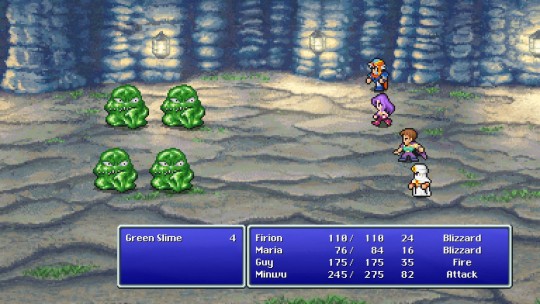
The original Final Fantasy was released in 1990 in North America and found some success, so work had begun to go into Final Fantasy II – there are English prototype roms out there to prove it. However, note that release date: 1990. The Super Nintendo would release in North America in 1991. In Japan, Final Fantasy IV was set for release in that very year. So what makes more sense logically? Release Final Fantasy II in 1991 – at the earliest – on a rapidly aging system that nobody plays anymore or skip it and release Final Fantasy IV instead?
Final Fantasy II was skipped, relegating it to the same fate that Mario Lost Levels would have. Since the Internet was in its infancy, most people playing Final Fantasy II on the Super Nintendo weren’t aware that they were actually playing Final Fantasy IV. Square would not correct the Final Fantasy numbering internationally until Final Fantasy VII and by the time VII came out, respectfully, very few people cared about the three titles they were missing out on. Final Fantasy II would not receive an official release in North America until 2003. Ironically, on the Playstation 1, which was in itself a rapidly aging system that nobody played anymore. But hey. It was here!
So was it like Mario 2 in that it was skipped over for a reason in that it was kinda middling and samey? Was it like Zelda in that it was too different for most? Was it like Castlevania in that it was hard to figure out without some guidance?
All is not as it seems
On a surface level, Final Fantasy II looks very similar to the original game. In the NES version, most character sprites look like recolored versions of sprites that showed up in the original. The main character, Firion, looks just like the fighter with some extra work done. Another character, Guy, looks like the sprite edit of the Thief. It looks visually uninspired and some might even think it’s a touch up of the original release. The combat is also very similar feeling. It’s still a turn based system and it largely relies on using physical attacks or magic.
That’s on a surface level though. When actually playing the game, the player realizes that Final Fantasy II is actually a fair bit different than the original and that realization starts immediately. When the player creates their party, they are no longer making four blank slate characters with no personality traits or dialogue. Instead, they get four characters with canon names who have dialogue. The original game was definitely an adventure with story as set dressing whereas this game eyed offering more of a story to go along with that grinding.
The story isn’t going to win any awards – this was a Famicom/NES game after all – but things are more fleshed out. The player’s main party joins a resistance movement, highlighted by Princess Hilda of Fynn (currently on exile in Altair) and Prince Gordon of Kashuan, to fight against the evil Palamecian Empire that is using demons and technology in order to conquer the world. Every town the player goes to has unique NPCs with unique Empire-related problems. The character section in the last article was relatively short but in this game, it felt like every location had someone new and interesting thrown into the mix. Characters have more to say and they give the player more motivation to go from one location to the next.
Adding to this expanded story is something called the key terms system. You can learn specific terms from NPCs and then ask other NPCs about them, which can change their dialogue and give you more story or direction. This small little step makes the storytelling feel a lot more immersive than in the original game. The player’s conversations with these NPCs that spout like three lines of dialogue total feel more like actual conversations because they are answering questions for the player. It feels interactive! The player doesn’t get key items and have NPCs just psychically know that they have the item, the player has to present it to them specifically. This system would never come back but it does a really impressive job of making Final Fantasy II feel like it has some sort of grand narrative.
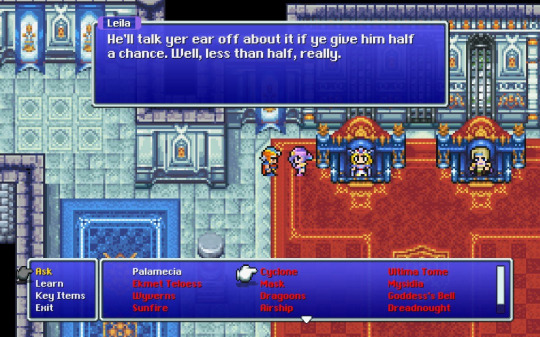
Having an actual cast of characters is really nice for those of us who started with later, story heavy Final Fantasy titles. Yes, you can role play as your thief in Final Fantasy I, but at the end of the day “GP or HP?” is a character that lives exclusively on your game cart or save file. When you talk to someone on the playground, they won’t know what the hell you’re talking about. With II, if you want to talk about the main character, everybody has the same one. Firion. Or maybe “Nathan” if you’re one of those weirdos who names RPG characters after your real friends.
I definitely named Aerith and Tifa after a crush or two in my day, no judgement here.
Oh! Aerith! That reminds me…on top of having more narrative, the game takes on a decisively darker tone than the original Final Fantasy. Yeah, chaos and Garland are no good assholes trying to take over the world. But do they actually kill anyone? Thinking as hard as I can, I can’t think of a single character or NPC that gets killed by the bad guys. In fact, every single death in the game can be attributed to the Warriors of Light. Murderous jerks. In 2? Well…
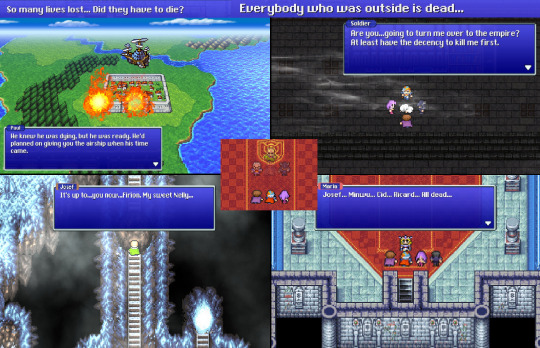
You thought Aerith was the first character to die in Final Fantasy history? No. If you meet anyone remotely important, there is a good chance they bite the bullet at some point. There are literal bombings on cities that take place in this game. Death is all over the place. It reminds me of when people are talking about what will happen at the end of a popular show – it always involves the question of ‘whether X character will die.’ I remember so much speculation about the potential death of Don Draper at the end of Mad Men. Death isn’t the only way to make something tragic! Still, Final Fantasy II kills off roughly a billion characters. I suppose it’s nice that the bad guys actually kill more people than the main party this time around.
The nitty gritty
For as different as this game feels from a narrative standpoint, it feels even more different when you’re actually grappling with the ‘core’ gameplay. I described the original Final Fantasy as a game designed with grinding in mind. Final Fantasy II takes this idea and supercharges it. There are no longer traditional levels. Instead, every single skill your character has needs to be leveled in some way. If your character wants to get better at evasion, you better make sure you have a shield. Got a fancy new sword? Better go out and do some random battles so your character can actually wield it properly. Have you ever played Morrowind? You know how when you start the game your character moves at like two miles per hour and if you want to get quicker you gotta, well, keep moving? This is a lot like that.
The goal of this is to create an immersive experience. If the player wants Maria to play like a white mage, simply teach her the proper skills, give her the right gear and her stats will progress in that way. If the player wants Firion to just be the warrior from FF1 simply jam on that attack button baby and they’re like halfway there.
I looked around to find if there were Western games released around this time frame that incorporated these mechanics. Leveling up every single thing is not terribly uncommon in CRPGs, for instance. But I could find nothing. So I’m not comfortable with saying that Final Fantasy II was the first video game to do something like this, but I will say it feels like Akitoshi Kawazu – the designer most people credit for Final Fantasy II being the way it is – got into a time machine and grabbed a bunch of mechanics from the 90s and tossed them into a blender for a console game released in 1988. Seriously, it feels nuts that an NES/Famicom game from the 80s would have this kind of stuff in it. I would love to ask someone like Todd Howard if they drew inspiration from Final Fantasy II of all things.
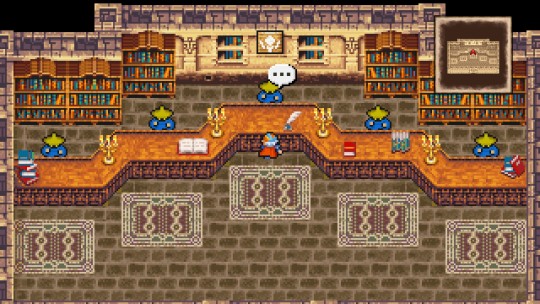
The way I approached the Pixel Remaster version of II was me just playing the game naturally. I had tried playing Final Fantasy II in the past and read about how cruel the leveling system is and just kind of fell off. The consensus best way to level stats for your characters was to wail on each other over and over again until you felt you were strong enough to continue. If you wanted to have your HP increase, you had to perpetually walk around with your HP very low. You needed to cast fire on yourself over and over and over again until it leveled up. Trying to play this way was an immediate turn off, so my suggestion to those playing FFII for the first time is to simply move forward. Don’t worry about over grinding spells and weapons until you HAVE to worry about it.
It’s still a bit of a cruel system because no matter what spell the player is casting, it needs to be worked on. For instance, this game has Esuna. In Final Fantasy X when Yuna casts Esuna, it cures all status ailments as soon as she learns it. In Final Fantasy II, when Firion learns Esuna, the only status ailments it can cure are Poison and Darkness. The player has to keep leveling it up to cure Amnesia, Toad and Stone. On top of that, you also have Basuna in this game. Esuna cures status ailments that persist after battle while Basuna cures status ailments that fade after battle. So if a character gets confused, the player needs to cast Basuna on him. Esuna does nothing. Of course, the player needs to level Basuna up to level 6 in order to cure confuse and the later FF mechanic of just smacking the shit out of a confused party member doesn’t work. So there is a need to grind both Esuna and Basuna if the player wants to effectively deal with status ailments. And you know what that entails? Casting Esuna and Basuna over and over again to no effect in battle. It gets tedious.
This game is grindy. It felt grindy even in the Pixel Remaster and as I noted in FF1, that version took a lot of the grind out of the original. My strategy when going from one dungeon to the next was to just cast spells on repeat in order to level them up. This did not cover all my skills though, at some point I had to pick and choose. So by the end of the game I was using Flare, Holy and Ultima pretty much exclusively as my damage dealing magic. The only buff skill I really bothered with was haste because it was really useful in the original but found it pretty lacking here. So my trips in dungeons consisted of me using the same spells over and over, running out of MP (the D&D-esque charge system is gone) and then attacking over and over. It felt dull and repetitive here, so I can only imagine how an NES player in 2024 would feel.
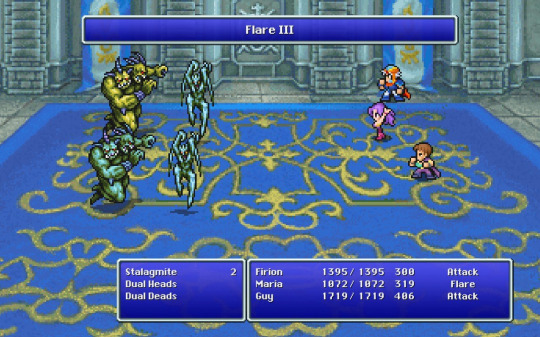
Jackassery
Speaking of dungeons, they are much more lengthy and involved here. I found that basically every one had multiple floors with lots of twists and turns. Even though I feel like my MP wasn’t lacking, I had to cut off my magic grinding less than halfway through most dungeons because I suddenly wouldn’t have the ability to heal myself. I feel like needing to grind every little aspect of your character is a poor combination with the resource management required of early Final Fantasy. This approach encourages the player to grind away from their main objective and as a result, the journey through dungeons feels unexciting because to conserve resources, they mostly running away or just jamming on the attack button. These dungeons are far lengthier than what showed up in FF1, you don’t want to run out of magic halfway through.
Also. This game is an asshole. Observe.
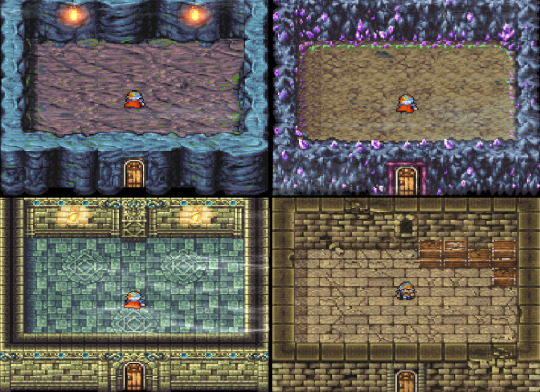
This exceptionally boring looking screenshot compilation is of four empty rooms. Your eyes do not deceive you, they are entirely empty. Nothing. What if I told you every single fucking dungeon is full of these empty rooms? They’re just there for seemingly no reason. If you’re like me, you try to get every single treasure chest that you can. You need those stinkin’ potions! So naturally you go from room to room trying to find all these chests and you get met over and over again with empty rooms. If there are five rooms on a floor, odds are that four of them will be empty. Sometimes more. But I’m gonna check every time because what if the fifth door has something? This actively punishes the player for exploration and encourages them to stick to the main path. If the player goes to every side room, they’re probably gonna get into more random battles, which will further drain their resources. It feels like you are being punished for trying to engage with the game.
Going back to Kawazu’s wacky time machine, I want to discuss another open world WRPG mechanic. Sometimes a game will gatekeep the player from certain areas by placing exceptionally hard enemies in their path. If someone were to run straight for New Vegas at the beginning of Fallout New Vegas, they are probably going to run into Cazadors and Deathclaws, the hardest enemies that game has to offer. It’s a subtle way of telling the player to fuck off. An unsubtle way of this is seen in basically any Pokemon game, where the roadblock can range from “some guy is thirsty” to “a bunch of people are hanging out here for some reason.”
At the beginning of Final Fantasy II, I was mashing monsters left and right. Nothing felt out of the ordinary. However, I went one pixel too far to the left and I encountered this.

I screencapped this because I was excited to see a bomb already. Hell yeah dude, a famous Final Fantasy enemy! What this screencap doesn’t show you is that these bombs self destructed for around 300 or so damage, well beyond what my characters have here. It should be noted that Bombs show up in the final dungeon too. Granted, by then they are pretty weak and easy to manage, but they are legitimately a final dungeon enemy. By going like a pixel off the main path I got destroyed. Some players find these early hard encounters useful for grinding spells since harder enemies equals better stat gains, but since I was trying to do a straight up playthrough without looking for too much guidance, this just served to annoy me. It ensured that I would basically not move a fraction off of the main path. Plus, in a game without autosaves, a random encounter that blows you out can make you lose hours of progress and it just isn’t fun.
There are also things the game doesn’t flat out tell you. Characters can wear any kind of equipment and equip any sort of weapon they want, which is good. But, unless I missed it, they don’t mention that wearing certain equipment has penalties. Heavy armors, shields and certain weapons cut your magic expertise by as much as 70%. The game doesn’t say that your mages actually need to dress like mages if they want to be successful (and if it does, I missed it), so you might just think your characters all suck ass at magic and never bother with it. And then, if you want to level up your defense or your evasion, you need those things, so if you’re aware of this mechanic you might feel the need to have grinding equipment and fighting equipment. Neat for MMOs. Extremely, extremely tedious for single player games.
Did you know that you basically go through the entire game with three characters? Now you might be looking at screenshots and notice that there are four characters in each one, but Final Fantasy II uses a rotating fourth cast member. This character changes all the time and after the first one, they kind of are all useless. Why? Because you haven’t grinded all of their abilities, stats and magic. You quickly get the impression that these characters leave you, so why would you waste time and effort making these characters as powerful as the main cast when they are just going to go away in an hour? You get a permanent fourth at the very end of the game and by then, do you really want to build this guy up so he can cast flare as well as the rest of your party can? As I said, this game is an asshole.
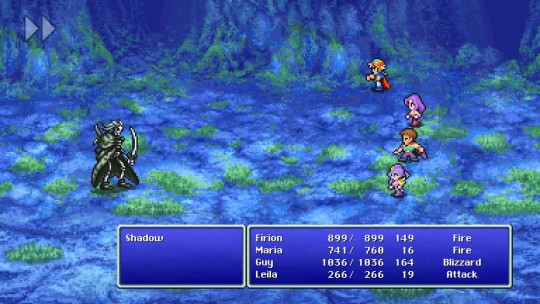
The trimmings
I want to briefly touch on music here. In my Final Fantasy I writeup, I wasn’t terribly kind to the music. I said the Pixel Remaster tracks felt like they came off of an assembly line. So using the magical power of 2024 technology, I modded in the original soundtrack into the Pixel Remaster and I gotta say it’s fantastic. The songs are all very catchy and they feel like they were composed with the NES’s sound chip and limitations in mind. I found myself humming tunes when not playing the game far, far more than I did with FF1’s remastered soundtrack. When playing these games, I think it is absolutely essential to put on Uematsu’s original soundtrack. It’s just fantastic. Sometimes just sticking with the original thing is the way to go and prettying it up for, well, whatever reason, is just unnecessary. I’m not a music guy so you’ll have to excuse me for the shallow analysis.
Final Fantasy II is an ambitious title. It sets out to do so much more than what Final Fantasy I accomplished. It takes the ideas of Final Fantasy I and expounds on them in many ways. I admire it for setting the series tradition of reinventing themselves for each new title. Without Final Fantasy II being a strange mess, you don’t have the weird game about a bunch of orphans with amnesia as the follow up to the game about a bunch of revolutionaries fighting against an evil corporation. I think it had a lot of interesting ideas, but ultimately feels too mean to truly recommend to anybody. I would say if you want to understand the Final Fantasy franchise as a whole, it’s important that you play and try to complete this game. The amount of things here that would go on to be staples in video games as a whole is really impressive, but if you’re looking for an actual solid game that you’re going to want to play over and over again? You should look elsewhere.
The cast
Unlike with Final Fantasy I, you have quite the collection of characters here. Just like with that game, I decided to compare character sprites between the Pixel Remaster and the original.
Firion

The main character of the game. As you will notice here, he borrows the Warrior sprite from the original Final Fantasy (NES). In the remaster, he gets altered to look more like the official artwork for the character. I was against drastic alterations to character sprites in the original Pixel Remaster, but I feel like since the original Final Fantasy II looks so similar to Final Fantasy I, changing things up is acceptable. These are actual characters now, so making Firion’s sprite just the generic fighter sprite feels unfair to him.
This is still an early JRPG, so Firion still doesn’t have a lot to his character. If I were to sum it up best, just think of generic main character dialogue and you have most of what he says. It’s nothing impressive, but it’s a start. They do have one thing with his character I really like though. There’s a scene where there is an imposter masquerading around as Princess Hilda. In this scene, she tries to seduce Firion – it gets so far that the rest of the party just leave the room because I guess they wanna let Firion get his freak on. And it even seems like it’s going to happen! This is like 30-something years before Clive and Jill laid naked on the beach in Final Fantasy XVI.
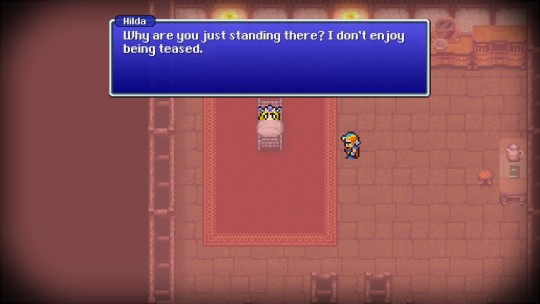
Of course, this is a fake. But it’s a neat little touch to his character. Yeah, he gets all horned up too! I just thought it was hilarious that the party, including Maria who I am pretty sure is supposed to be Firion’s love interest, are just cool with him randomly going to town on the princess during a pretty tense time in their world.
The way I used Firion here was pretty disjointed. At first I tried to make him a magic and sword wielder. I tried to make sure fire, blizzard and thunder were always fairly highly leveled but – since I wasn’t willing to take my armor off during big fights – I decided it was ultimately useless to focus so hard on that. In the end, he became a fairly dedicated warrior and when equipped with the blood sword, he made absolute short work of the final boss of the game. It was actually such an easy victory that I thought maybe I was playing something other than Final Fantasy II. I’ll take it!
Maria

I really like how close the Pixel Remaster keeps Maria’s character portrait to the original. It basically looks the same but less pale. To me, her NES sprite looks like a female warrior. I am pretty sure it’s also a reuse of an FF1 sprite since I think this is how Princess Sarah looks in the 8-bit Theater comics, but I don’t know for sure so I’ll give them the benefit of the doubt. Her new sprite matches her hair color instead of the weird red->purple thing the NES has going on so I like that.
Maria’s actual character is…uhm…I have no idea actually. I feel like she maybe says three words for most of the game. Then you meet her brother who has been acting as the dark knight for the empire the entire game and her character becomes ‘brother of the former bad guy.’ She’s there. But this is your first canon female party member – the white mage in FF1’s gender is ambiguous – so I guess take what you can get?
So when I play games like this, I like to have my lady characters be magic users. Like everyone else in the world. So Maria was pretty much doomed to be my magic flunky throughout the game. Until I got Ultima, her main usage in combat was to be the party healer. I made sure Cure, Esuna and Basuna were all as leveled as I could make them and generally speaking I never ran into too much trouble. I think I ran into two game overs the entire way? Not bad. As a result of this, I will name her MVP of my party.
Guy

Another case where I think the Pixel Remaster does a great job of capturing what the original portrait is going for. I am curious to see how the remasters handle IV-VI considering those are SNES games. Just like with Firion, his Remaster sprite is made to look more like his official artwork which I think is a good call because his original sprite is just a recolor OC Do not steal of the Thief.
Guy’s personality is very simplistic. Apparently his official backstory is that he was raised by wolves. I don’t remember this being brought up in the game, but the first couple of times I saw him speak I thought maybe the font pack I installed with my game altered and fucked up the translation. No…he just talks like a caveman because he’s something of a wild man. Think a more useful version of Gau from Final Fantasy VI, but with none of the bad guy copying skills.
In my playthrough, Guy was an axe wielding mad man who I tried to make proficient in magic but ultimately found it not worth the effort. I didn’t keep it up as long as I did with Firion, but I did at least try to make him a viable Holy and Flare user. I failed, mind you, because with my armor all equipped he was only doing like 100 damage with level IX holy but an effort was made. Perhaps I need to get good. During the endgame, Guy took on some healing duties since I had Maria focused on casting Ultima. But I can’t say he was too great at it. Kind of a jack of all trade and a master of none. Like the red mage!
Oh and he can talk to beavers. He’s the best character in the game.

Guy indeed speak beaver.
Leon

Another warrior edit for this guy, but I kinda like that decision because it gives him and Firion a bit of a Dante and Virgil from Devil May Cry thing. Speaking of Virgil, I feel like his NES portrait looks a bit like what an NES portrait of Virgil would look like. The remaster went with black hair because I guess that’s what his character art looks like. Okay. Probably the one character where I prefer the original.
Despite being the fourth main character on the character naming screen, you don’t actually get Leon until the very end of the game. This is because Leon spends almost the entirety of the game acting as the evil Emperor’s right hand man and generally being an evil asshole. Eventually Leon turns against the emperor and joins the good guys, but it’s not like he ever gets a true character arc. I’d say he’s like a really dumbed down version of Shadow the Hedgehog. No I will not elaborate.
Since Leon is the dreaded ‘fourth’ party member that I mentioned above, he didn’t do much for me at all. I think I just had him attack blindly during the final dungeon. I did teach him flare and a couple of other odd magics but he never really needed to use them because Firion with his blood sword and Maria with ultima were just dominating everything. He got to be part of the final party that saved the world but didn’t contribute very much. What a jerk!
Minwu
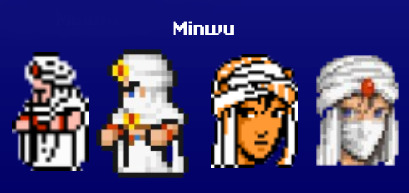
I love Minwu’s NES sprite so much. It looks like a character from Mario 2 (U.S.). I think they did a good job of recapturing the feel of it for the Pixel Remaster but damn. The original rules. I also don’t know why they decided to mask him up for the Pixel Remaster when he is maskless in the original. You’re a handsome dude Minwu, no need to hide that face away!
His character trait seems to be reliability. The Joe Kido of Final Fantasy II. He is Princess Hilda’s trusted white mage advisor person and is tasked with joining the crew to go get some mythril so the resistance forces can make some cool weapons to fight the emperor. He leaves the party so he can focus on healing up the King of Fynn. He comes back at some point to help the party acquire ultima and ultimately sacrifices himself to save the group. One of many deaths. But Minwu was an exceptionally useful party member so I was sad to see him go.
He is the first ‘fourth’ party member of the game and honestly he sets unrealistic expectations for the rest of the fourth members. He comes equipped with a bunch of leveled up white magic skills. I mean, just look at this shit

I think my other characters had like 20 MP and level 2 spells max at this point. I liken him to someone like Frederick from Fire Emblem Awakening. A character you get early to make things seem easier. Fredrick becomes useless later because other characters catch up and surpass him whereas Minwu becomes useless later because he leaves the party and fucking dies.
Josef
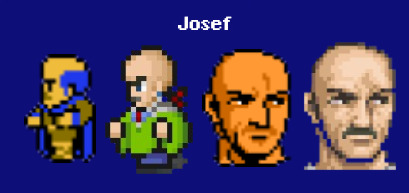
I love Josef’s sprites. The first one just looks like an old businessman LARPing as an elf. The Pixel Remaster one gives him a gigantic forehead because he does all of his exercising at the library.
Josef is a bit cold towards the party when you first meet him but he eventually becomes a big ol softie when Firion and crew save his daughter from slavers. His main purpose in the game is to give the party a snowcraft in order to transgress an impassable snowfield in order to obtain an item called the Goddess’s bell. He joins you briefly and is probably the most useless of the ‘fourth’ party members. He doesn’t come with any magic and while he fills the monk role you’d see a lot of later – he fights with his fists you see – I don’t think he ever did very much damage. Like Minwu, he dies saving the party. His death involves saving you from a giant boulder!
Leila
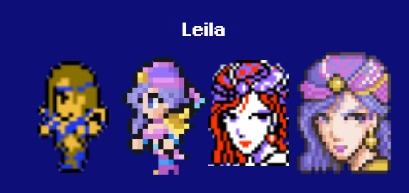
Looks just like a recolor of Maria, so automatically I prefer the remaster’s sprite. I think they did a really good job of making it match with her new portrait. I don’t think I like her having purple hair instead of red hair – especially since we already have one purple haired lady in the crew – but that’s a nitpick.
Leila is a pirate and hooks the party up with a boat, which allows them access to most of the world. There are really only a couple of places that you can’t reach by boat so it’s probably the most useful boat in the franchise? I guess we’ll see. She starts off mean, remember pirate, but joins the party as another relatively useless fourth party member. Unlike Minwu and Gordon she doesn’t die, though I was concerned when she got separated from the party in the Leviathan dungeon, and ends up being a big part of the resistance against the empire. She doesn’t have much of a personality but the pirate lingo makes her stand out so I always liked when she would show up. At the end of the game she suggests Firion becomes a pirate with her, which apparently upsets Maria. Firion is a lady’s man!
Gordon
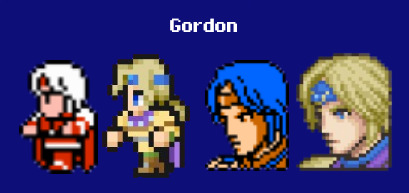
Damn, I love Gordon’s NES sprite. The white hair looks cool on him. I don’t understand why the NES portrait looks like Marth but, you know, that was the style at the time.
Gordon is the prince of Kashuan and has probably the only thing resembling a character arc in this game. He starts the game being a depressed coward because he feels like he let his brother, Scott, die. Eventually he decides to prove himself and in doing so helps the party defeat a giant airship that had been bombing all of society. The king of Fynn even acknowledges him and gives him a prominent position in the rebellion’s forces. He later agrees to partner up with Hilda, the princess of Fynn, in order to build up their kingdoms from the depths the empire has plunged them to. It’s not exactly the most compelling character arc, but it’s something! Oh and he’s another useless fourth party member. I got nothin’ on his gameplay because I legitimately don’t remember it.
In some versions of Final Fantasy II, Scott is a playable character. I generally feel like the bonus dungeons added to some Final Fantasy ports really suck and are rarely worth doing, but hey, he’s there if you want him. Since this remaster is supposed to be relatively faithful he was not a playable character here. It’s okay Scott, you were engaged to Princess Hilda before the game started, you won in some small way right?
Ricard
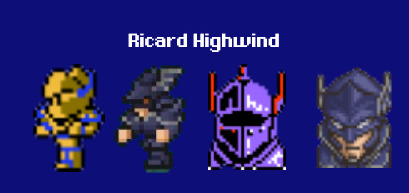
God damn look how cool Ricard’s NES sprite is. And he’s a good guy! This guy would have been a mega hit over here if it hadn’t released 15 years later. Since he’s kind of a dark character, I definitely agree with the decision to make him look kinda edgy in the Pixel Remaster. I don’t like his portrait as much though. Hide that mouth fella.
Ricard plays the role of the last dragoon in the world. That’s right, the extremely popular and beloved dragoon class debuts here. Want a character to be a megahit? Give them a spear and make them friendly with wyverns, odds are they will be one of the most popular characters in your game. Your party meets Ricard in Leviathan’s guts and he basically just exists to save the party from the emperor. He sacrifices himself so your party can regroup and challenge the emperor another day. Three of the five ‘fourth’ characters die. Not good odds!
In combat, Ricard had a pretty damn solid attack stat because he was putting up numbers comparable to Firion while he was in my party. He is probably the most useful fourth since Minwu, but he isn’t around long enough to make much of an impact. He also has no magic but he was hitting so hard that I didn’t mind it for once.
Princess Hilda
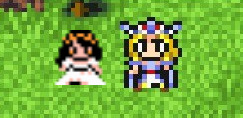
Princess Hilda is the second princess in the Final Fantasy universe and immediately she is a lot more memorable than Princess Sarah. Why does Sarah get used so much more in other media? It’s not fair! Her deal is that her kingdom, Fynn, has been overtaken by the empire so she is working with rebellion forces to take it back through their hideout in Altair, the game’s first town. She ends up giving the crew a lot of their tasks, starting with FIND MYTHRIL and evolving to STORM FYN AND TAKE BACK THE CASTLE. She was engaged to Gordon’s brother Scott at some point, but he died and I believe the game suggests her and Gordon are going to pair off now in order to help recover the world. Neat.
I decided not to make a separate character entry for the King of Fynn because he spends the entirety of the game either sick in a bed or dead. He’s not much of a character, so I consider Hilda the true face of the kingdom.
Cid
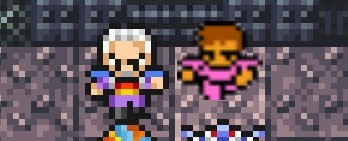
I like how NES Cid looks like Dan Hibiki of Street Fighter fame.
This is the official debut of the eternal Cid character. For those of you that don’t know, every Final Fantasy title has a character named Cid in it. Their importance varies from title to title. In some Final Fantasy games he is an important NPC, in some he is a playable character and in others he is an old mechanic that lets you perv on his mechanic daughter. He is typically an engineer of some sort or has a fondness for airships.
In Final Fantasy II he falls into the NPC line of Cids. His main purpose is to provide air travel to the party – at first he has an attendant that will charge you to fly to various world map locations but eventually you get his airship because he dies. A net gain, dare I say?
Paul
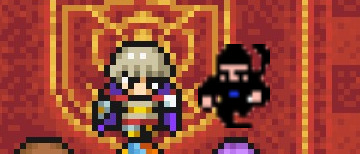
Paul is a thief character that is part of the resistance. He owes the party a debt because they saved him from a bunch of slavers in the game’s first dungeon, Semitt Falls. To repay this debt, Paul busts the crew out of prison, gives information about how to open up a secret passage at Fynn castle and even gives you a blood sword – well the location to it anyway – if you talk to him at the right time. The blood sword makes the end of the game a complete cakewalk so I really like Paul! The NES version of him appears to play up on his status as a thief by making him a ninja while the remaster goes more with updated renditions of his appearance. I prefer ninja Paul, he doesn’t have a bowl cut.
My favorite sprite, Ogre Mage

Just like with Final Fantasy 1, I just wanted to highlight a random enemy sprite I really like. This time it’s a very early enemy called the Ogre Mage who…yeah, I bet you can guess everything about him by his name. I really like the shadows over his eyes, it makes him look really demented. He reminds me of Sloth from Full Metal Alchemist.
Forces of the Palamecian Empire
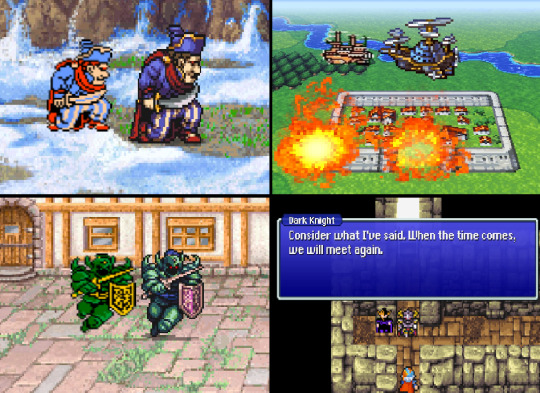
The main badguys of the game! The connection between all of the villains is made a lot more obvious here because they are all part of the same empire, there isn’t some 2000 year relationship going on! So let me break down these four screenshots real quick.
Upper Left: Borghen. He’s a sniveling coward who betrays the kingdom of Kasuan because he sees the tides turning and wants to join the winning team. He’s portrayed as incompetent, though he does manage to kidnap Josef’s daughter Nelly at some point. The party runs into him while trying to find an item called the Goddess’s Bell and the boss fight is great because it’s one of those times where the gameplay matches what the story tells you – this guy is a joke. But upon death he triggers a boulder that kills Josef because even this joke character has to get a confirmed kill. I like to think this guy laid the ground for characters like Solt and Peppor from Chrono Cross or Zorn and Thorn from Final Fantasy IX.
Upper Right: The Dreadnought. The first portion of the game involves the rebellion trying to destroy this thing. It is a warship of immense power and is probably the most devastating weapon that the empire has available to them. You destroy it by trekking through it like a dungeon and tossing some sunfire into the engine. I found this to be one of the game’s more intimidating dungeons because I ran out of MP about halfway through, I had no ethers and I couldn’t exit to go heal up. I was very grateful there wasn’t a big boss at the end of the dang thing. I was pretty surprised when an early game cutscene shows this giant ship just flat-out bombing cities. Impressively, it even changed the look of the city. I’m not sure if this happened in the NES version or not, so if this is a Pixel Remaster exclusive…nice touch!
Lower Left: Captain. The Captain is not a major character, but I thought he would be a good choice when talking about the grunts of the empire. When the party goes to Fynn, something strange happens that doesn’t happen in any other town in this game. Random battles! This is an excellent little bit of gameplay serving the story because Fynn is overrun by the empire so it makes sense that this town is swarming with baddies. The Captain comes in as an elite unit the party has no chance of beating the first time they arrive into town. You are told to stay away from them – they aren’t random battles, they are NPCs – because you don’t want to raise alarms that the resistance is moving around. It would be wise to listen to the warnings because the Captain one shot every member of my party with ease. When you actually liberate Fynn later in the game, it feels like some nice progression being able to explore the town without fear of a Captain wrecking you.
Lower right: The Dark Knight: Final Fantasy titles love their brooding dark knights. The Dark Knight here is the right hand man of the emperor for most of the game and later tries to ascend to the throne when he believe the emperor has been killed. It turns out that this character is Leon, the party’s fourth member that they were separated from at the beginning of the game. The game never says why Leon turns to evil but I appreciate that they never excuse away his actions by saying he was brain washed or he couldn’t help it. When he joins the party, he never acts overly friendly towards them either. He’s just there because a bigger threat arrives. I think he’s probably the most interesting villain in the game just because what drives him is mostly a mystery.
The Emperor
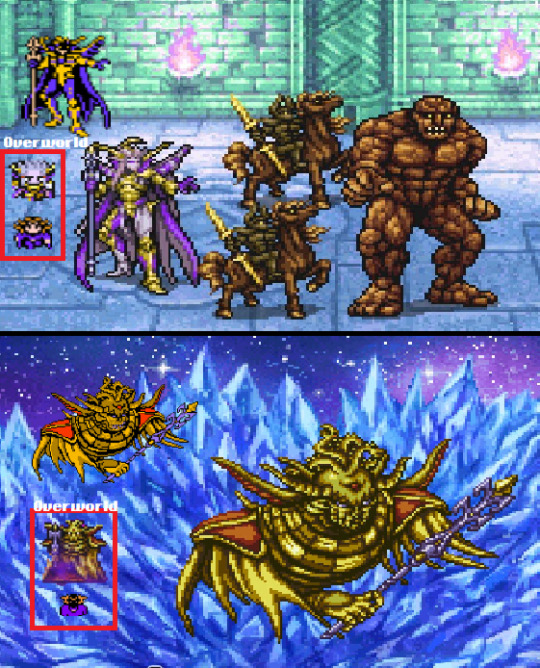
Apparently this guy is also known as Emperor Mateus, but I never saw that in the game so I’ll stick with just calling him “The Emperor.” If you close your eyes and think of the most generic evil dude ever, well, you got him. He wants to destroy the world and will use magic and technology to achieve those goals. In your initial battle with him, he is portrayed as something of a coward because he summons a bunch of guards to help him out. He’s a bit of a pushover here. The game goes to a lot of lengths to convince you that he’s dead and that the Dark Knight is now the true main enemy. They even celebrate his death with a fun dance at the castle in Fynn!\
He’s not done though. He comes back from the dead by conquering hell or something – the specifics of it are vague but he says that he gained powers in hell and will topple your forces and presumably the world. This is when the Dark Knight decides to become Leon again and help the party save the world from the obviously bigger threat. I think the Remaster does a good job with his overworld sprite because he looks far more intimidating and boss-like upon his return.
The Emperor serves as the final boss of the game and compared to Chaos he’s a bit of a joke. If you remember with Chaos, I had went beyond the level cap of the original Final Fantasy and was still struggling to defeat him – it was an absurdly challenging battle that represented a large step up in difficulty from the rest of the game. The Emperor on the other hand is stupidly easy, as long as you have the blood sword. Firion was causing like 7,000 damage per hit with his sword and Maria was causing over a thousand with Ultima. Maria also still had normal armor equipped so if I had died, I would have stripped her down and assumedly hit far harder. He’s probably a fair deal more difficult without the blood sword, but if the game is going to give me an easy way to deal with the final boss, why wouldn’t I do that?
It started here
Here is a look at some franchise staples that got their start with this game.
Cid, the word Highwind (Ricard’s last name), main character deaths, Final Fantasy ‘sequels’ having nothing to do with the previous entry
These are touched on above so I won’t go into much more detail about them. The Cid thing is fun because everybody knows about Cid and everyone has a favorite Cid. Me? I’m a basic bitch and my favorite Cid is Cid Highwind from Final Fantasy VII. The word Highwind also goes on to become a bit of a Final Fantasy staple. Fun fact, in the very first Kingdom Hearts game you have to run a race against Riku, the rival of the main character Sora, and the reward for winning is the ability to name your ship. In my first playthrough, I of course entered the name Highwind and was pleasantly surprised to see that Riku had also chosen that as the name for the ship. It felt extra good considering I don’t think I have ever won that race despite playing Kingdom Hearts 85,000,000 times in my life, so I never actually got to name the ship myself, but it still got the name I wanted. Why does Sora act so distressed over it? You got the name you wanted buddy!
The sequel thing is definitely the most important part here and is a key element of the franchise. I think III regresses things a little bit and is a bit more like the first game, but generally each new Final Fantasy reinvents itself in some way and feels a lot different than what came before it.
Chocobos
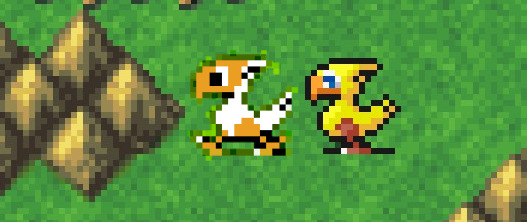
That’s right, we got our first mascot! The Chocobo Forest is south of Kashuan and is pretty well hidden, to the point that it almost feels like an easter egg for players familiar with the franchise. But no, it was always there and Final Fantasy II is just a mean game that doesn’t want to give you easy access to a ‘skip battle’ mechanic.
The chocobo functions much like it does in later games. You find one and ride it around the world map. You can’t enter towns with it, but while you are riding you move quicker and random encounters are disabled. In the console version of the remaster and modded PC versions you can just turn off random encounters if you want to, so the chocobo being here is even more of a ‘fun little easter egg’ for those players.
Sadly no chocobo inbreeding until Final Fantasy VII.
Unwinnable battles
A fine JRPG tradition like no other. Occasionally you will have fights that you can’t win no matter what you do and just exist to progress the story. The one I remember most vividly in my head is Beatrix from Final Fantasy IX. This game starts out with an unwinnable battle that separates Leon from your crew and gets your characters to join the resistance. I like these in the sense that it really helps show your party’s progression when you fight unbeatable enemies again and come out on top.
Familiar monsters
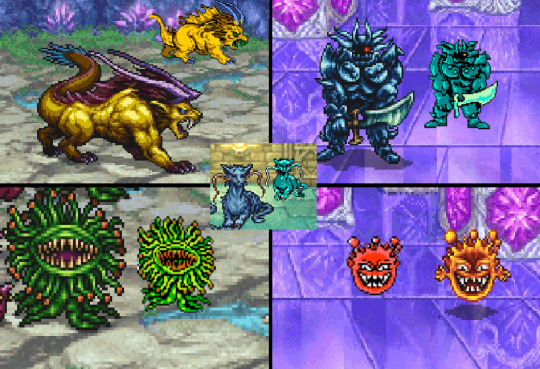
I feel like it’s a good thing to point out the first appearance of iconic enemies in the franchise. Here’s a little mashup of some familiar faces. The one that may not be as immediately obvious is the iron giant in the top right. He looks far more sinister than later incarnations of that baddie, I actually prefer this aesthetic. I think I like the NES version of the (King) Behemoth because it looks like it has a giant fin on its back. Ya gonna go swimming or something buddy?
MP (Magic Points)
Mentioned exceptionally briefly above, but Final Fantasy I used magic charges while this game introduces the MP system to the Final Fantasy franchise. Most games in the franchise use it from here on out, with the most prominent exceptions leaping to mind being Final Fantasy VIII (which replaces it with the junction system) and Final Fantasy XVI (which is an action game and has different mechanics all together). I think the charge system worked great for what Final Fantasy I was going for, but MP suits the franchise better as a whole.
Ultimate weapons for real this time, I swear
The Excalibur comes back! Again! But this time it’s overshadowed by the blood sword, which I am far more comfortable in calling an ultimate weapon than the Masamune or Excalibur from the original. The blood sword doesn’t work against every enemy in the game, its actual stats are lower than several other weapons, but it does work against every big enemy in the final dungeon which I think goes a long way into cementing its status as an ultimate weapon. There are several hard enemies that pop out in chests in the final dungeon and the blood sword makes short work of them and I’ve already mentioned how the final boss gets obliterated by it.
Dual wielding weapons
What would later go on to become the calling card of the ninja job, dual wielding starts here. Every character can dual wield every type of weapon, except those that require two hands to wield (bows). You can also dual wield shields if you want to. This is handy for grinding up weapon levels since you can do two types if you so choose to. For me, in more cinematic titles, when a character reveals they dual wield they instantly become way cooler. To mention Kingdom Hearts again, one of the things I remember the most about the original’s secret ending is when the mysterious cloaked figure (who would go on to become Roxas) pulled out his second keyblade. At that very moment I became obsessed with what the next Kingdom Hearts game would look like. I would like to think I have Final Fantasy II to thank in some small way for that.
In conclusion
Final Fantasy II is an ambitious but flawed game that can feel like it’s actively punishing the player for trying to get the most out of it. It feels like a game created with knowledge of future mechanics but without the knowledge of what makes them work or fun to engage with. I admire the heck out of it and cannot bring myself to hate it, I legitimately don’t understand people who plop it on ‘worst game ever made’ lists because it absolutely doesn’t belong there.
Just like with the original Final Fantasy, it’s a good idea to at least try the NES version before jumping into the Pixel Remaster. It’s nice to gain some perspective on what it originally looked and felt like. Unlike with the original Final Fantasy, I feel like you don’t lose out on a whole lot by sticking with this version of the game. Even with some quality of life and balance tweaking, the Pixel Remaster still feels like an ancient grindy NES game.
For most players, you only need to play a little bit. There is no need to beat the whole thing just to claim you’ve beaten every Final Fantasy. It’s worth sticking through to see all the innovation as it can help you appreciate what the title is going for, but don’t feel bad if you get annoyed and bounce off of it.

#Final Fantasy Retrospectives#Final Fantasy II#retro#retro gaming#video games#opinion#ps5#switch#pc#Final Fantasy
0 notes